

Cat on a Boat 101: How to Sail and Live Aboard with Cats

As an Amazon Associate, we earn from qualifying purchases. We also earn from other affiliate websites. See our full disclaimer .
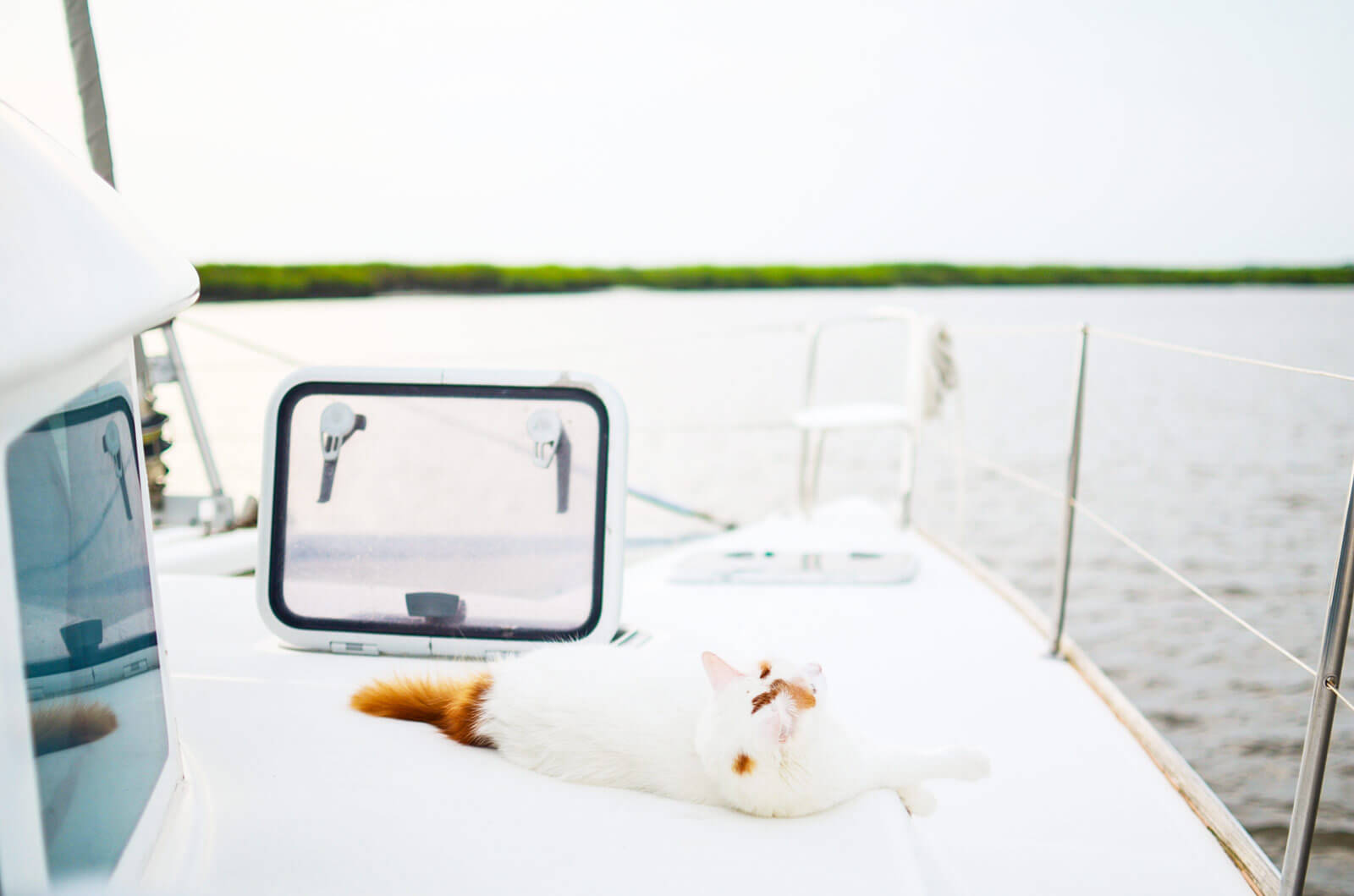
At first glance, having a cat on a liveaboard boat may seem like a lot of work and maybe not even possible. However, with patience and preparation having a cat on board can be a wonderful experience for both you and your feline first mate.
We’ll help you get started with prepping your boat for your cat’s arrival, finding gear you might need for your new liveaboard kitty, and how to keep your cat safe and healthy on board.
Getting Started with Your Boat Cat
Are you wondering if you can take a cat on a boat? I’m happy to report it is possible to turn your everyday house cat into a full-blown adventurous sailing cat.
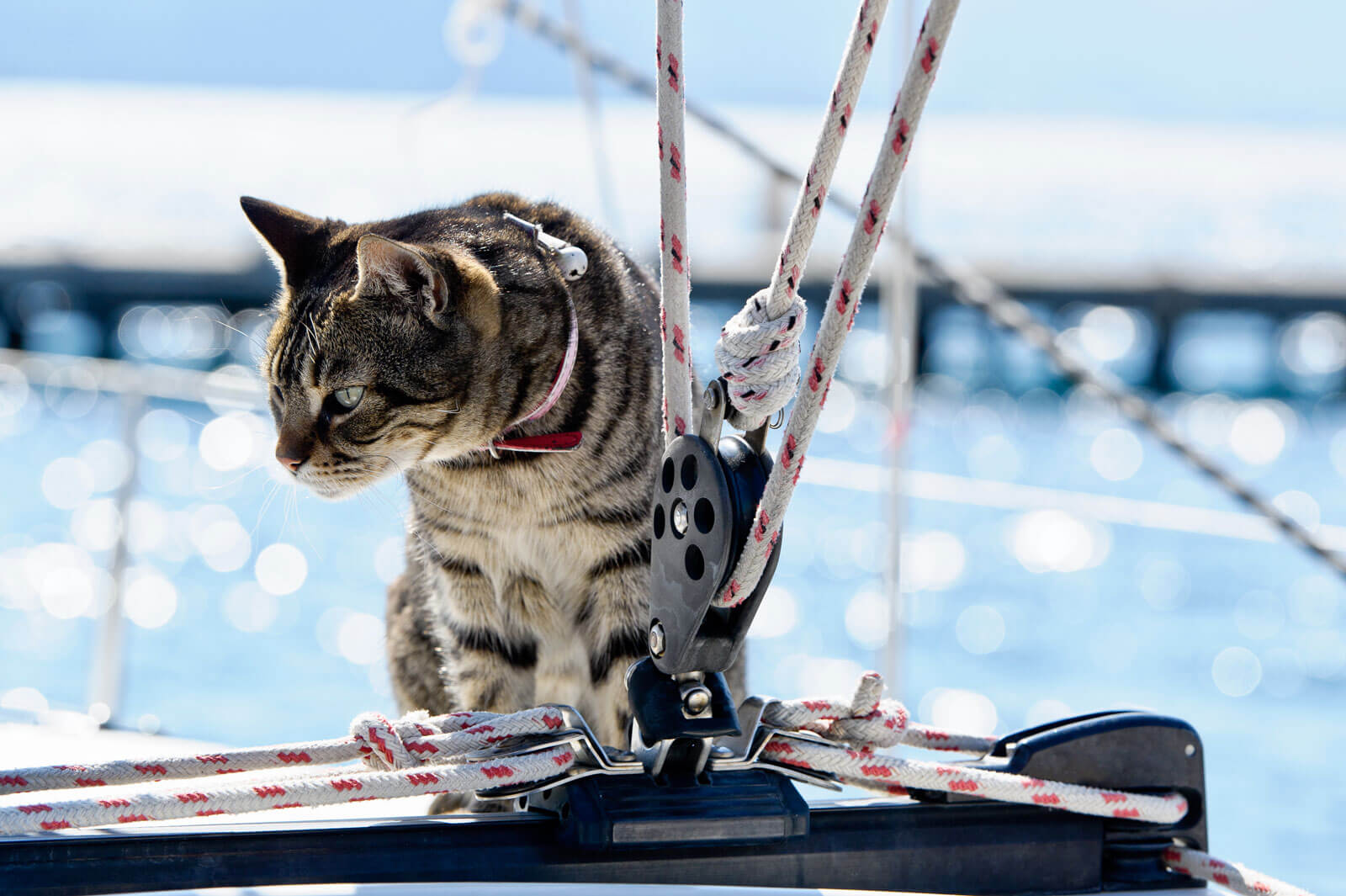
Some kitties may take to boat life quicker than others, but eventually, most cats can become happy liveaboard boat cats with the right approach.
Introducing Your Cat to the Boat
We introduced our cat to our 38-foot sailing catamaran by having short visits (2-4 hours) while the boat was at the dock. We would work on the boat, and Augustus would come along and hang out. Once we moved onboard, he already felt comfortable in the space.
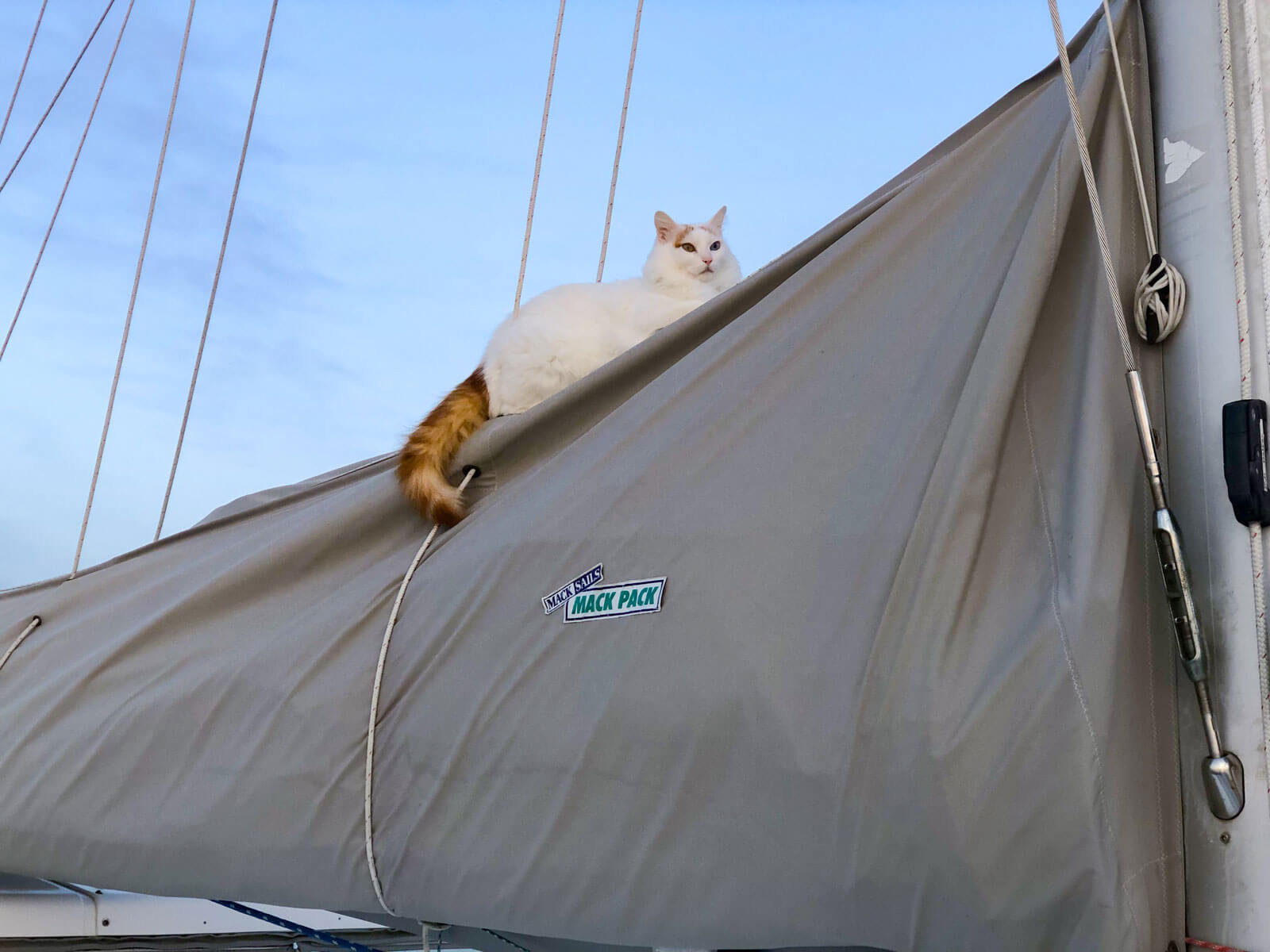
We would occasionally run the engines and let him get used to the sound. When we finally left the dock, he was still getting used to the engines and would find a spot down in the V-berth to hide. The more we traveled, the more comfortable Augustus became. He eventually started coming up on the bridgedeck, sitting in the windows and sometimes popping into the cockpit in calm seas.
No matter how accustomed your cat becomes to the boat, everyone is uncomfortable in rough conditions. Allow your cat some space since they might feel queasy.
Cat Proofing Your Boat
Cats are notably mischievous. If you don’t keep your wits about you, this can be a problem on a boat!
Any time we open a hole under a settee or open up a wall, Augustus is right there to see what’s happening.
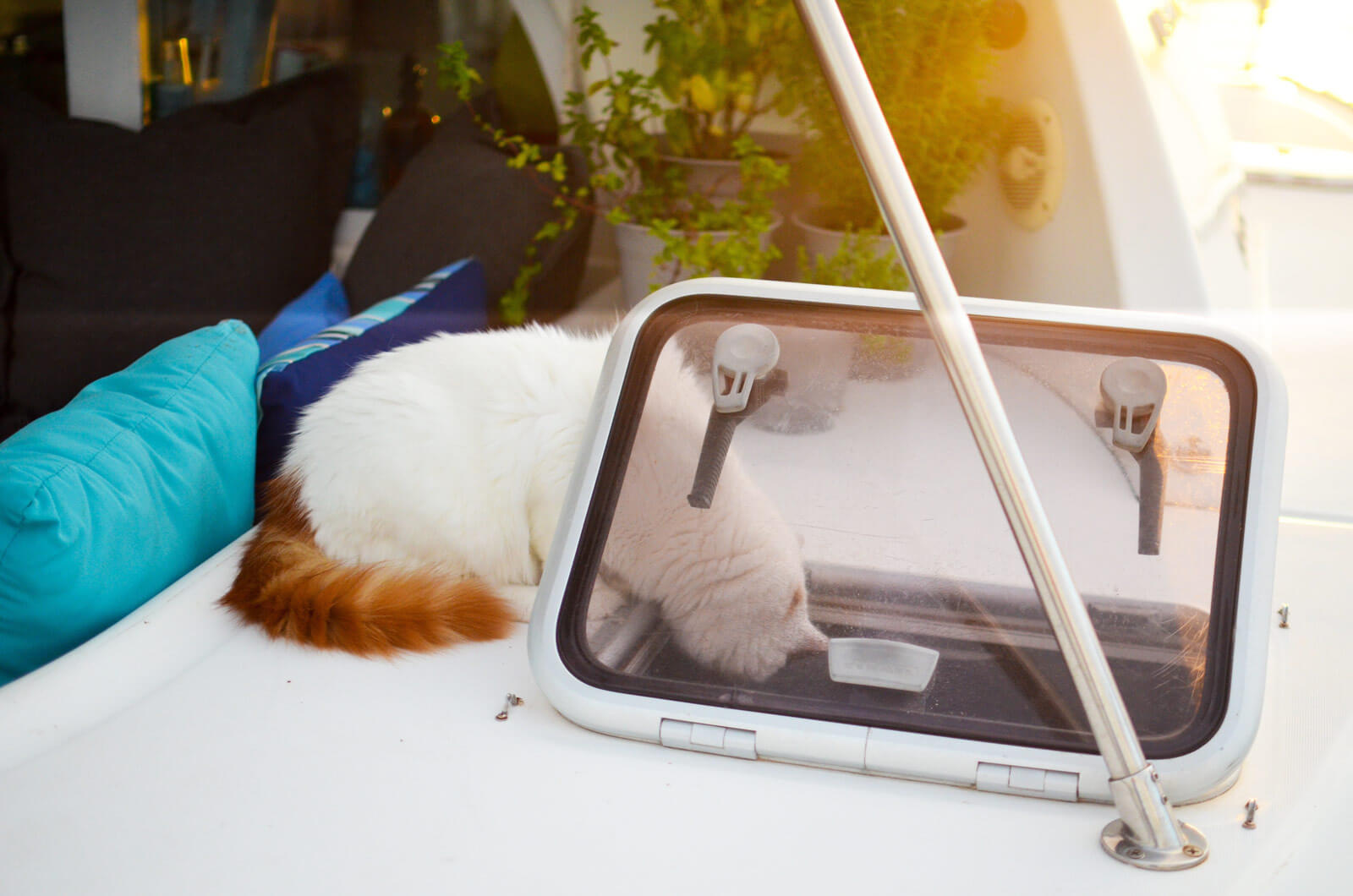
Augustus has been stuck in the bilge for the better part of a day AND locked in a berth all night because the door swung closed. One time he even climbed through the settee in the bridgedeck and managed to pop out in an access hole under the bathroom sink in the starboard hull. The moral of the story – if you need to run a wire, get a cat!
But seriously – with a cat aboard, don’t leave any hole accessible. No matter how small, no matter how short a period.
Cats and Seasickness
Many cats are like humans. They feel sick for the first day or so on the water, and then they start to feel better.
Signs of seasickness in cats:
- licking lips a lot
- uneasy demeanor
Fresh air is as essential to them as it is to us. Getting them in the cockpit might help, but don’t push it if they are scared.
Most cats will find a spot to ride out the queasy feeling.
You can get anti-nausea medications from a vet for severe circumstances as a last resort.
Cruising with a Cat in Hot Climates
A question we often get is how do you keep your cat cool when sailing in hot climates.
Here are a few tips to keep your cat cool on hot days.
- wet bottom of paws, nose, and ears if the cat becomes overheated
- use wind scoops for airflow and leave hatches open with screens in to keep your cat inside but the air moving (we often use this setup on anchor when we go to shore)
Cat Food On Board
If you’re cruising on your boat, you’ll probably want to stock up on cat food just as you would other essential food items.
When we buy cat food, we get an 18-pound bag of dry food along with many cases of wet food.
To keep your cat’s dry food fresh, it must be in a sealed container. You don’t want moisture or any critters getting into that precious kitty food supply. Also, you don’t want your cat turning up their nose at stale kitty food halfway through the supply.

We use the Vault pet food storage container to keep cat food fresh and love it!
We also use a smaller container such as this one for daily feedings, so we aren’t constantly opening the long-term food storage container. This method helps keep the cat’s food freshest. We have never had any contamination with this system.
You might also want to consider a kitty food mat to ensure food and water bowls stay in place when underway. We like this mat from CatGuru . This works on a catamaran, but you might need to store the bowls when underway on a monohull.
Suggested Cat Food Products
Cat food and storage products we love for living on a boat.
| $20.25 | ||
| $22.70 | ||
| $9.99 | ||
| $26.99 |

PRO TIP: We like Chewy.com for ordering pet food on the go in the US. They offer 1-3 day shipping on orders over $50. You can order a few days ahead and have it shipped to a marina along your route.
The litter box.
Managing a litter box is always a complex task, and it is especially challenging in a small space such as a boat.
Boats are usually in motion, don’t always offer an easy way to dispose of waste, and can be very humid.
Here are a few ideas for handling these obstacles.
- Invest in a top entry litter box to contain the litter
- Use a Litter Genie to store cat waste until you can dispose of it (it works just like a diaper genie)
- Find a location for the litter box that will have the least amount of humidity

Choosing a Litter
There doesn’t seem to be a perfect litter choice for cats on a boat. Every option has pros and cons. Below is the litter we use and another popular option from cruisers. Both of these options let you avoid carrying hundreds of pounds of litter around on your boat if you are cruising in remote waters.
- Breeze Cat Litter System – Boat owners seem to really like the Breeze Cat litter box. When the cat does its business, the pee falls through the box onto a pee pad below. The poop is scooped. Because the urine is separated, the litter pellets in the top of the box last a lot longer than the average litter. There are concerns about the price of the pee pads and the litter pellets. We’ve heard of cat owners who have bought 3rd party pads and have found ways to wash and reuse the pellets. There is a ton of information on this system if you search the Gatos Del Mar Facebook group .
- Pretty Litter – We have been using Pretty Litter for four years now. It’s nice because it lets you know if your cat has any health issues within the urinary tract. This synthetic litter is non-clumping, soaks up pee, and allows you to scoop the poop. It minimizes the amount of waste we add to the Litter Genie since it is non-clumping. However, it works by soaking up urine, which is not great for a humid environment and doesn’t last as long on a boat.
Suggested Cat Litter Products
Durable and long-lasting litter products we love for boat life.
| $25.99 | ||
| $21.99 | ||
| $42.98 | ||
| $23.99 | ||
| N/A |
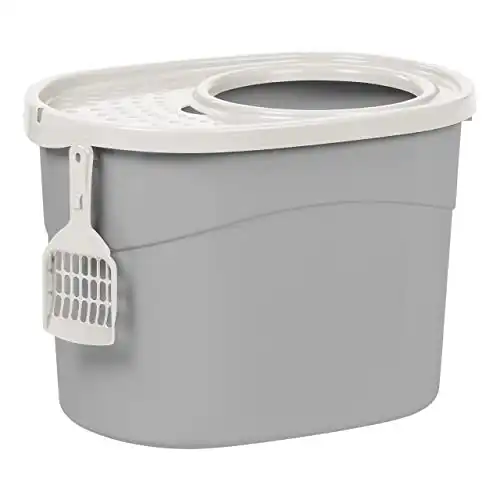
NOTE: Some boat owners toilet train their cats to avoid dealing with a litter box onboard. Training can be a long process that requires patience, but it might be worth the effort, especially if you have a young cat who is eager to learn.
Gear for cats on boats.
Boat and sailing cats need a few more pieces of gear than the average cat. Here are some items to help your kitty stay safe while still enjoying themselves on a boat.
Life Jackets for Cats
So when should your cat wear a life jacket? Short answer – it’s totally up to you.
Watch your cat closely in their first few months aboard. They will be finding their rhythm and testing their limits. This is the time when our cat took his first dip in the ‘drink’ (and he was without his cat life jacket). I would suggest putting the life jacket on your cat more often upfront until your cat becomes more familiar with boat life. Once they start getting their bearings, you can choose to put it on them less.
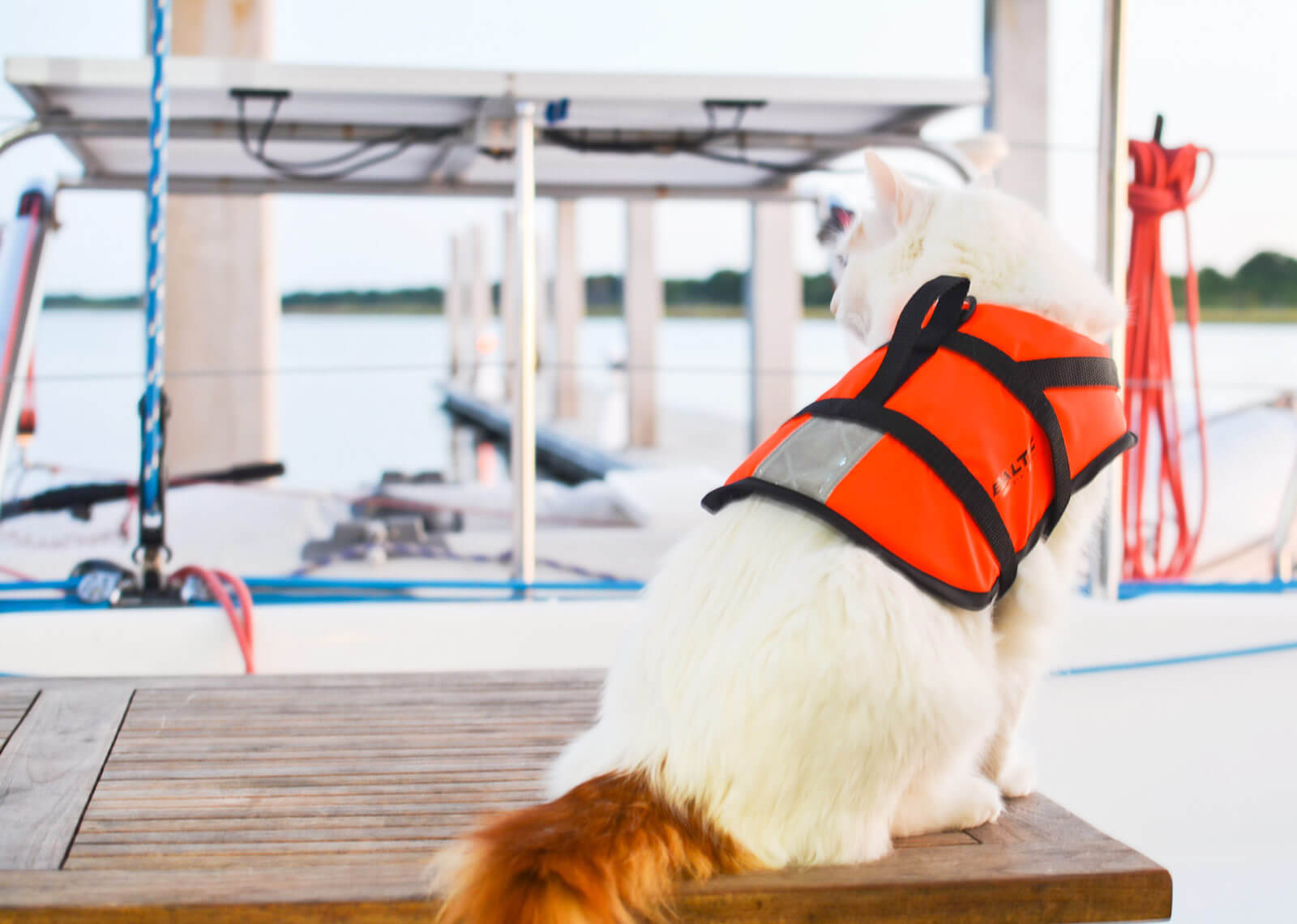
Can Cats Swim?
Most cats can swim. They just don’t particularly want to. Many cruisers will train their cat to climb a rope on the side of the boat if they fall over. Augustus could easily climb up on the sugar scoop of our catamaran in calm water, and that’s just what he did when he fell in at the dock.
PRO TIP: If your cat does fall in the water, make sure you bathe them. Marina water is especially dirty and can contain diesel fuel and “other things” that might come out of a boat. You don’t want them licking themselves without first getting a bath.
Cat life vest suggestions.
Cat life jackets are pretty hard to come by. Below are a few life vests designed specifically for cats that come highly recommended in the cat owner boating community.
Baltic Maja Pet Buoyancy Aid – A cat-specific life jacket with a smaller neck opening than what you see with most dog-designed jackets. It also has an extra strap underneath for more support.
Lyra Cat FFD (Feline Flotation Device) – A cat-specific life jacket similar to the Baltic but also has a built-in harness for extra comfort. This jacket was designed and tested by a sailing cat owner.
SurferCat Life Jackets – Another life jacket made just for cats. This one is designed by a pro wakeboarder who wanted something for their cat that is very minimal and built with performance and mobility in mind.
Cat Backpack or Carrier
You’ll want a way to transport your furry feline if you are living aboard.
We love our backpack carrier because it makes moving Augustus around in this lifestyle easier.

The backpack offers hands-free carrying on and off the boat. It’s a stable and safe carrier for our cat, whether we have to cab, walk, or bike to a vet or other location.
They even have backpacks that expand for comfort traveling in a vehicle. Search cat backpacks on Amazon here.
Harness and Leash
Harness training your cat is one of the best things you can do to make your and your cat’s new life easier on a boat.
It will allow you the freedom to take your cat for walks at the marina or dinghy them to shore for land time.
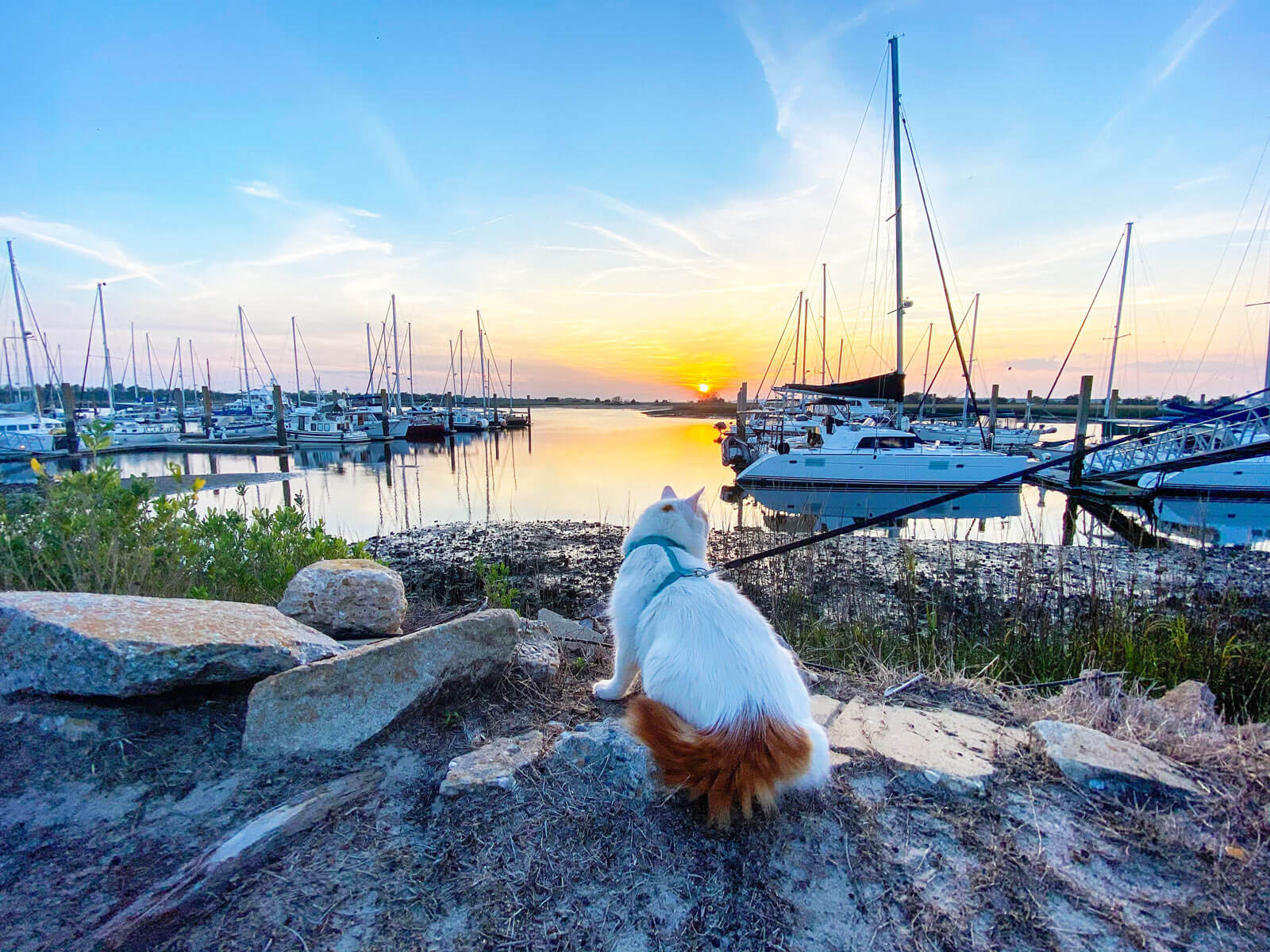
Once your cat is harness trained, don’t let your cat on deck or off the boat without a harness. This approach can keep your cat from darting out the door, and they will associate the harness with time outside.
We’ve used many different harnesses over the years. Here are a couple of our favorites:
| $33.00 | ||
| $15.98 |
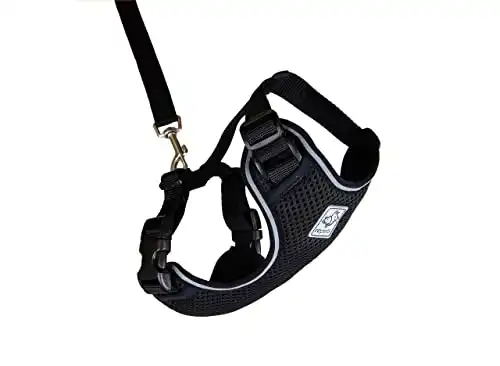
PRO TIP: Make sure whatever harness you choose as an adjustable neck for the best fit.
Cat trackers.
A tracking device is another good idea when you have a cat that wanders off the boat in a marina or one that you take ashore.
The longer our stay in a marina, the more comfortable Augustus becomes venturing off the boat. Occasionally, he might slip by us and wander up the dock (or onto another boat) without anyone noticing.
Trackers are great for quickly locating your kitty on the dock or even finding them if they wander away from the marina.
Here are a couple of trackers we have used and our reviews of each.
| $34.88 | N/A |
| Inexpensive compared to other trackers Small and lightweight compared to most trackers Water-resistant The battery is easily replaced after months of use Within range, you can 'ring' the Tile to locate your cat | Track at any distance with the data connection Live tracking mode to view cat’s movement in real-time Can alert you when your cat leaves a designated area Small size compared to other GPS trackers Waterproof |
| Out of the 400-foot range, there is no tracking No directional tracking (you get status updates (‘moderate’ or ‘strong’ signal), but you can’t tell in which direction | Requires a monthly data plan Needs charging once a week (on average) Live tracking mode will drain the battery quickly Data plan will not work outside of the U.S. Will scratch easily if you don’t purchase the optional cover/sleeve |

The Tile Pro is a Bluetooth tracker that is intended to track things like your keys, but we found it was an affordable option that worked well to track our cat. We attached it to the D-ring on the cat’s harness. The Pro version has a 400-foot range.
- Inexpensive compared to other trackers
- Small and lightweight compared to most trackers
- Water-resistant
- The battery is easily replaced after months of use
- Within range, you can 'ring' the Tile to locate your cat
- Out of the 400-foot range, there is no tracking
- No directional tracking (you get status updates (‘moderate’ or ‘strong’ signal), but you can’t tell in which direction
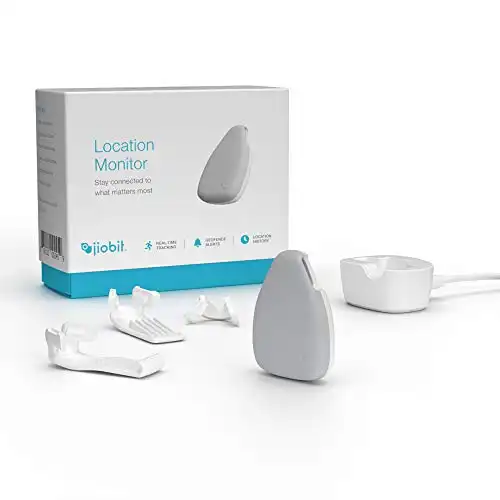
The Jiobit is a tracking device designed to track pets, children, and/or seniors. This device uses Bluetooth, Wifi, and a required cellular data plan to track the person or pet the most accurately while conserving battery life.
- Track at any distance with the data connection
- Live tracking mode to view cat’s movement in real-time
- Can alert you when your cat leaves a designated area
- Small size compared to other GPS trackers
- Requires a monthly data plan
- Needs charging once a week (on average)
- Live tracking mode will drain the battery quickly
- Data plan will not work outside of the U.S.
- Will scratch easily if you don’t purchase the optional cover/sleeve
PRO TIP: As a backup, we have Augustus microchipped (this is required to check into some countries). We also attach a pet ID tag to his harness with our phone numbers. We have also seen cat owners that have their contact and/or boat information embroidered into the harness. There are shops on ETSY that will do this for you.
Vet & pet health.
Pet care can be a little tricky when you are traveling often. Especially on the water.
Here are a couple of tips to ensure your cat is taken care of.
- Always keep a good account of your cat’s health records. We keep a digital file so we can both easily access them. This way, when we visit a new vet, it’s easy to give them all the information they need.
- If you have pet insurance, make sure you are covered in the area you are traveling.
- Talk to your vet about putting together a kitty first aid kit

Traveling to Different Countries with Your Cat
If you are planning to travel to different countries on your boat, you’ll need to check each country’s requirements for cats.
Many countries will require a health certificate to enter the country. If you are going for a health certificate, you need an appointment for just the health certificate. The appointment can’t also be for a checkup or other issue. Most countries will also require a 1-year rabies shot (instead of a 3-year), FVPR, and possibly the feline leukemia vaccine.
Check noonsite.com for details on cat check-in requirements for different countries.
More Resources for Living Aboard with Cats
Luckily, there are quite a few people out there sailing with cats! You can find more information when you know where to look.
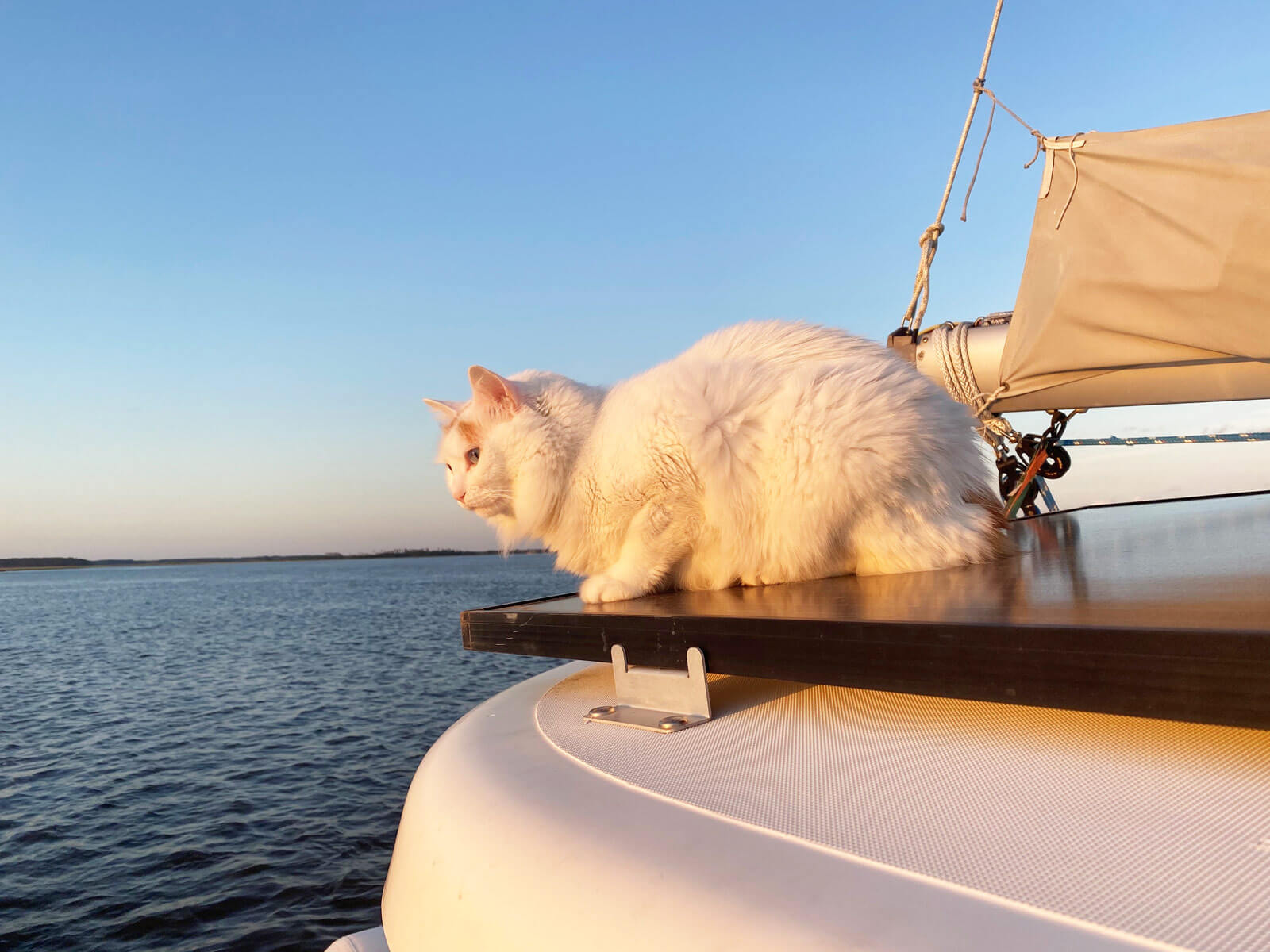
- As mentioned earlier, the Facebook group Gatos del Mar has a ton of great information about living on a boat with a cat. You can search this group for answers or ask questions.
- Instagram accounts also have great information. I love following Miss Rigby’s account on Instagram . Rigby is a boat cat that lives aboard with her owners full-time. I’ve messaged them before with sailing cat questions and they were very helpful!
- Adventurecats.org or the book Adventure Cats: Living Nine Lives to the Fullest – this organization has a lot of great info about harness training and traveling with your kitty!
READ NEXT : If you explore by land and water, you might also like the post How to Go RVing with Cats: A Complete Guide .
Final thoughts on boating with cats.
Cats are creatures of habit, but they are also very adaptable. Use the information you’ve gathered and set up a welcoming boat environment for your cat. Have patience and listen to your feline’s responses to their new home.
If you do these things, you and your cat can have some incredible experiences together on the water!
Want to learn more about what it’s like cruising on a boat?
View our guide to read more on life on a boat and what to expect living on the water.
Like this post? Save it on Pinterest for later.
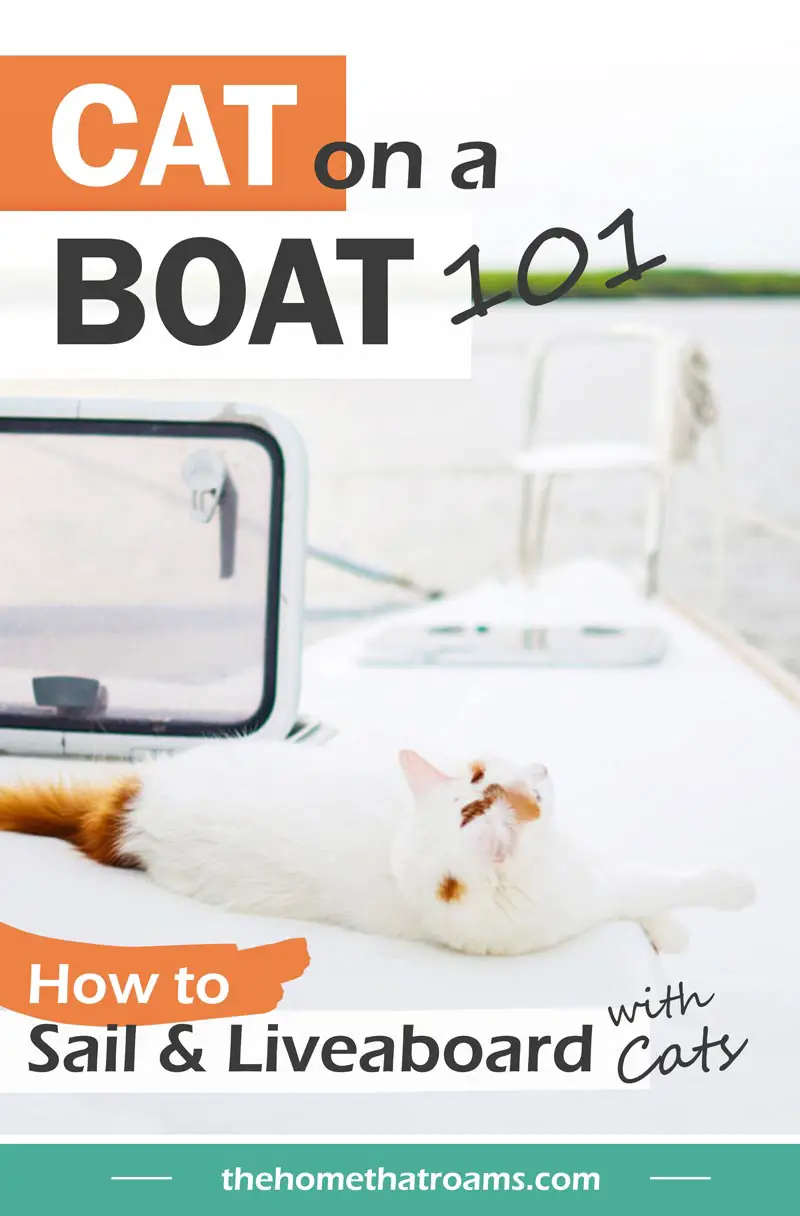
Morgan, the founder of The Home That Roams, has been living nomadically for over five years. She began her journey traveling across the U.S. in a motorhome and cruising on a liveaboard sailing catamaran. Currently, she lives full-time in a travel trailer, sharing resources on RV living and boat life to help others downsize their lives and thrive in an alternative lifestyle.
Love this site!
Thanks so much! Glad you are finding it helpful.
Leave a Reply Cancel reply
Your email address will not be published. Required fields are marked *
Sign Me Up!
Learn how to live on a boat.
Get weekly tips on how to start traveling full-time on a boat.
View our privacy policy .
Privacy Overview
| Cookie | Duration | Description |
|---|---|---|
| cookielawinfo-checkbox-analytics | 11 months | This cookie is set by GDPR Cookie Consent plugin. The cookie is used to store the user consent for the cookies in the category "Analytics". |
| cookielawinfo-checkbox-functional | 11 months | The cookie is set by GDPR cookie consent to record the user consent for the cookies in the category "Functional". |
| cookielawinfo-checkbox-necessary | 11 months | This cookie is set by GDPR Cookie Consent plugin. The cookies is used to store the user consent for the cookies in the category "Necessary". |
| cookielawinfo-checkbox-others | 11 months | This cookie is set by GDPR Cookie Consent plugin. The cookie is used to store the user consent for the cookies in the category "Other. |
| cookielawinfo-checkbox-performance | 11 months | This cookie is set by GDPR Cookie Consent plugin. The cookie is used to store the user consent for the cookies in the category "Performance". |
| viewed_cookie_policy | 11 months | The cookie is set by the GDPR Cookie Consent plugin and is used to store whether or not user has consented to the use of cookies. It does not store any personal data. |


Cats On Liveaboard Sailboats - A Complete Guide

Last Updated by
Daniel Wade
June 15, 2022
Cats are fun, safe, and friendly companions to countless liveaboard sailors. Caring for a cat on a sailboat can also be easy.
Cats can live safely and comfortably aboard sailboats with proper space, ventilation, climate control, and safety precautions. Most cities and marinas allow cats aboard, and they’re easy to care for if you take a few extra measures.
In this article, we’ll cover everything you need to know about living aboard a sailboat with a cat (or two). We’ll go over the best breeds for sailboats, essential cat safety measures, indoor and outdoor cats, toys and entertainment, and how to keep your cabin clean.
We sourced the information for this article primarily from the tips of liveaboard cat owners. We also researched cat breeds and behavior, along with which cats are best suited for long-term living aboard a sailboat.
Table of contents
Can You Keep a Cat on a Sailboat?
Yes! Cats are some of the best pets to have aboard sailboats. They generally require less attention in terms of exercise than dogs, and many cats can acclimate easily to living on a sailboat. Cats offer great company, and they’ve been kept on boats and ships for decades.
That said, there are several unique challenges that cat owners face while living aboard a sailboat. We’ll go over the best supplies and strategies soon, but first, we’ll cover the rules and legality of keeping cats in liveaboard sailboats.
Marina Rules and Pet Regulations
The most likely issue you’ll run into is the marina itself. Some marinas that allow liveaboards have strict pet policies. These are instituted primarily for sanitation reasons, and violating the rules can get you kicked out.
Liveaboard slips are hard to come by these days, so it’s best to abide by the marina’s policies. Be sure to contact your chosen marina and make sure you’ll be allowed to keep a cat on board. Some marinas have policies strictly for dogs or outdoor cats, so you may be off the hook.
Local Pet Ordinances
Local ordinances apply in just a few situations. First, some communities set limits on how many pets can occupy a residence. These limits are usually based on square footage, which is where liveaboards usually run into trouble.
For example, a city or county may specify that you can only keep one pet per 100 square feet of interior space. These rules may or may not apply to mobile dwellings (such as RVs and boats), so it’s best to check first. Regardless, most standard cruising sailboats can only comfortably (and hygienically) harbor one or two pets at a time.
How Many Cats Can You Keep on a Sailboat?
This question depends entirely on your cleaning capabilities and the size of your sailboat. A 30-foot sailboat cabin gets awfully cramped with two or three cats aboard, not to mention the litter box problem. Multiple cats using a litter box in a well-sealed fiberglass tube isn’t a good situation.
As a general rule, it’s best to start with one cat regardless of the size of your boat. That way, you can get acclimated to taking care of a cat on a boat before taking on additional pets. For vessels under 40 feet in length, two cats is a reasonable limit.
Benefits of Liveaboard Cats
There are numerous benefits to living aboard a sailboat with a cat! The first and most common benefit is the companionship of having your pet aboard. It can greatly enhance the atmosphere by adding comfort and a real sense of ‘home’ in the very utilitarian environment of a sailboat cabin.
Additionally, cats are a great way to keep pests from occupying your vessel. Many sailors leave the hatches open during the summer, and sailboats are a five-star destination for mice and other disease-riddled rodents. Cats are humanity’s oldest and most effective pest control system.
Cats also provide a great opportunity to bond with other liveaboards. From arranging playdates to sharing common experiences, keeping a cat or two aboard your sailboat is sure to add an extra layer of quality to your experience.
Indoor or Outdoor Cats: Which are Best for Sailboats?
The indoor/outdoor cat debate has raged between homeowners for decades, and the question is even more important to consider as a liveaboard.
The primary issue here is that cats are difficult to keep contained aboard a boat. Sailboats have lots of large openings for people to move in and out of. Hatches and portlights present ample opportunity for cats to ‘escape’ and run off up the dock. Having an outdoor cat somewhat negates the issue, as they’re free to come and go as they please.
Outdoor cats are the easiest to deal with if you like opening up your boat frequently, and it frees up deck space for your cat to relax and exercise in your presence. However, outdoor cats can bring in ticks and fleas, which can rapidly overrun a confined space like a sailboat cabin.
Indoor cats eliminate the tick and flea issue, but you’ll have to keep a much closer eye on them. Some cats naturally won’t stray off the boat, so there’s a possible solution. And yes, it’s entirely possible to keep a cat from escaping a sailboat if some precautions are taken.
Which Cat Breeds are Best for Liveaboard Sailboats?
Believe it or not, there are several cat breeds that are adapted for life on the water. It’s no guarantee that your cat will swim like a Golden Retriever, but many breeds are known for their affinity for water.
The best cat breeds for sailboats are the American Bobtail, the Maine Coon, the Manx, the Japanese Bobtail, the Norwegian Forest Cat, the Turkish Angora, the American Shorthair, the Turkish Van, and most varieties of Bengal cats.
How to ‘Cat-Proof’ Your Sailboat
Cat-proofing your sailboat is essential if you’re planning to have one aboard. Cat-proofing refers to steps you should take to protect your cat from getting into areas where it shouldn’t be.
First, make sure to seal off any open access to the bilge. Sailboat bilges are often wet, unsanitary, and confined—which is just asking for trouble. Additionally, make sure your cat can’t get into the engine compartment or anywhere fuel and oil are stored.
Make sure to enclose access to electrical panels and wiring, as cats are known to chew up or destroy essential wiring and systems. Also, they can give themselves an unpleasant shock from rubbing against or biting into the wrong wires.
All other spaces on your sailboat should be safe for cats, as long as they’re accessible and open. Make sure to keep cupboards closed, and consider adding netting over deep cubbies to prevent your cat from getting stuck or trapped behind a panel or bulkhead.
Liveaboard Cat Safety
Keeping your cat safe aboard your sailboat can be easy. The main concerns are temperature, water, and the environment. Below, we’ll go over how to keep your pet safe and comfortable in the unique environment of a liveaboard sailboat.
Can Cats Swim?
Many cats can swim to some extent, but they usually don’t like it. Any cat owner who’s tried to give their cat a bath can attest to this fact. However, cats can be acclimated to the water with some patience and routine practice.
Lifejackets for Cats
It’s a good idea to spend time in the water with your cat, as you want to be sure it can swim if it falls overboard. Using a specialized cat life jacket is a great way to start. These lifejackets are also useful in an emergency.
Leashes and Harnesses
Having a leash and a good cat harness is a great way to safely let your cat enjoy the deck space of a sailboat. Many liveaboards attach a leash to the deck rail or a stay wire. A leash and harness essentially double the amount of space your cat has to hang out.
If it’s long enough, it’ll allow your cat to explore and hang out on the deck without running away. Just be sure to keep it untangled from lines and rigging. Don’t attach a leash to a collar, as it can be hazardous if your cat tries to jump off the boat or gets snagged in the rigging.
You can also incorporate a lifejacket into a leash system, which is especially helpful when making an offshore passage or getting underway. It’s a great and inexpensive upgrade for you and your cat.
Climate and Temperature
When it comes to temperature, the same rules that apply to cars also apply to sailboats. Never let your boat get too hot with your cat inside. Make sure the vessel is well ventilated, heated, and air-conditioned if possible. Sailboat cabins can get extremely hot quite fast. Remember, if you’re sweating, your cat could be overheating much worse.
Cats on Sailboats: Sanitation
Nobody likes to think about sanitation, but it’ll be the only thing on your mind if your boat isn’t cat-friendly. Small spaces can be soiled rapidly, especially with an animal onboard. However, you don’t have to resign yourself to a dirty space when you have a liveaboard cat.
Litter and Litter Boxes
Choosing the right litter and litter box is essential to maintaining a clean and disease-free sailboat cabin for you and your cat. Cat waste is noxious and must be contained effectively.
Don’t skimp on litter quality! Deodorants in cheap litter only mask the smell for a short time (if at all), so it’s best to find a product with odor-killing abilities. The best way to do that is to purchase high-quality anti-odor cat litter (the pricey stuff) and a partially-enclosed litter box.
Food and Water
Food and water are pretty self-explanatory aboard a sailboat, but it requires spatial consideration. You can still feed your high-quality cat food as long as there’s enough room aboard to store sufficient supplies. Additionally, you’ll need an anti-spill water bowl to prevent your floating home from rolling and spilling water everywhere.
Hair Control
Most cats shed, and cat hair isn’t the best addition to your upholstery. Thankfully, cat hair and other allergens can be controlled effectively with proper ventilation and cleaning tools. A simple dustbuster is sufficient for cleaning furniture and scooping up stray chunks of litter.
Ventilation
Keep that air moving! Cats need fresh air, and so do humans who live in confined spaces with cats. It’s easy to ensure your sailboat has adequate ventilation. Simply install a few solar-powered deck vents and crack a porthole. Additional passive ventilation (like a wind scoop) can be a lifesaver on hot and stagnant days.
Waste Disposal
You’ll probably have to clean the litter box about twice as often when living aboard a sailboat. The most important thing to remember is to get the waste off the boat as soon as possible.
Avoid flushing it down the toilet, as litter can expand and ruin pipes and septic tanks. Instead, bag it and take it to the marina dumpster. If you perform this task once every day or two, you’ll be in great shape.
Cat Toys for Liveaboard Sailboats
Keeping your cat entertained is pretty simple on a sailboat. Most liveaboard cat owners have a wide array of typical small cat toys. You could let your cat scratch up the furniture freely, though it’s better to find a place to add (or build) a scratching post.
Some sailors turn the bottom of a wooden bulkhead into a scratching post by stapling a sheet of thick cat carpet around the base. Other possible scratching post locations include the base of the mast, the centerboard trunk (if you have one), and the base of a table.
Related Articles
I've personally had thousands of questions about sailing and sailboats over the years. As I learn and experience sailing, and the community, I share the answers that work and make sense to me, here on Life of Sailing.
by this author
Most Recent

What Does "Sailing By The Lee" Mean?
October 3, 2023

The Best Sailing Schools And Programs: Reviews & Ratings
September 26, 2023
Important Legal Info
Lifeofsailing.com is a participant in the Amazon Services LLC Associates Program, an affiliate advertising program designed to provide a means for sites to earn advertising fees by advertising and linking to Amazon. This site also participates in other affiliate programs and is compensated for referring traffic and business to these companies.
Similar Posts

How To Choose The Right Sailing Instructor
August 16, 2023

Cost To Sail Around The World
May 16, 2023

Small Sailboat Sizes: A Complete Guide
October 30, 2022
Popular Posts

Best Liveaboard Catamaran Sailboats
December 28, 2023

Can a Novice Sail Around the World?
Elizabeth O'Malley

4 Best Electric Outboard Motors

How Long Did It Take The Vikings To Sail To England?

10 Best Sailboat Brands (And Why)
December 20, 2023

7 Best Places To Liveaboard A Sailboat
Get the best sailing content.
Top Rated Posts
Lifeofsailing.com is a participant in the Amazon Services LLC Associates Program, an affiliate advertising program designed to provide a means for sites to earn advertising fees by advertising and linking to Amazon. This site also participates in other affiliate programs and is compensated for referring traffic and business to these companies. (866) 342-SAIL
© 2024 Life of Sailing Email: [email protected] Address: 11816 Inwood Rd #3024 Dallas, TX 75244 Disclaimer Privacy Policy
- Destinations
- Marina Ranking
- Captain’s advice
- Environment
- Your stories
- Download Navily

Sailing with a cat on board

Cats have a reputation for hating water. But what do they really think about it? Is sailing with a cat that complicated? What if this water was full of fish for your furry friend’s next meal! From the safety of a boat deck, cats are in fact truly reliable sailing companions.
Take Jessie, the adventurous feline who has been sailing with her human Lyn since she was adopted as a kitten. We had the chance to interview Lyn about her experience on the topic of sailing with a cat. How does she ensure smooth sailing with her furry skipper on board? Keep reading for some tips and tricks from our own in-house expert! Who knows, maybe next time your beloved Whiskers will join you as well!
You can follow Jessie’s journey on her Instagram account @jessie_the_sailing_cat
Want to sail with your dog instead? Here is Thais, Beto and Google’s story on bringing your dog on board .
Sailing with Jessie: The interview

How long have you been travelling with Jessie?
“We have had Jessie since she was 8 weeks old and she has always been a ‘boat cat’. For the first 6 months we cruised on the inland waterways of England in our Princess 32 river cruiser. Following this, we had a Sealine 365 Flybridge cruiser for coastal cruising on the East Coast of the UK. Jessie always came with us.
In 2017 we became full time liveaboards on our Broadblue 385 sailing catamaran and of course took Jessie with us. We left the UK in July 2017 and have sailed almost 4,000 nautical miles with Jessie throughout the Mediterranean. So Jessie has been on boats since she was 8 weeks and we’ve been sailing with a cat for almost 7 years!”

Did you have any hesitations when you decided to bring her on board?
“We didn’t really have any fears about bringing Jessie on board as she had experience with us on our previous boats. Our main worry is her falling overboard, but she is very good and knows how to stay safe. She does have a life jacket, but she is not entirely comfortable wearing it as it is quite restrictive. Whilst we are underway, she is always safely tucked inside the bedroom.
However, when we are at anchor, her favourite time of the day is just after the sun has set, when she likes to wander around the deck. To allay our concerns about her falling overboard, we have a Safety Turtle . It attaches to her collar and sets off an alarm when it is submerged in water. However, having lived on board the catamaran for 3 years now, Jessie knows her ‘safe’ routes around the boat and onto the different roof levels and is really careful. We are extremely vigilant and either stay with her or check on her regularly.
In addition to this, we do have other safety systems in place. Inside the boat, her basket is fastened securely so that it does not fall or move when the seas are rough, giving her absolute security.”

Was there a transition period? How did you manage it?
“No, we didn’t have an adaptation period really. When we moved on board the catamaran full time, we all moved on board at the same time! Jessie loved it immediately. She has a 360º view of her surroundings and we are always moving to different places. This keeps her from becoming bored! She loves to sit and watch the birds and the fish jumping alongside the boat.
Jessie also loves that we are with her all the time now, rather than going out to work and leaving her at home alone. She has her own routines and gets upset if they are disrupted!”
What essentials do you recommend to someone who is considering bringing their cat onboard?
“We have the basics such as her litter tray, a plentiful supply of wet and dry food and her favourite toys, cushions and blankets. In addition, we have a special water filtration bowl for her that is powered by 12v (USB). We also have a separate veterinary first aid kit for her, including ear drops, eye drops and special swabs for minor wounds.”
Do you have favorite brands for Jessie’s supplies?
“We find that we can get good quality Purina food products in most countries and try to keep a variety on board at all times. Our water bowl is from Cat It . It is excellent because of its low power consumption and ability to run off 12v.”
Are there any issues with customs when sailing with a cat?
“So far our main cruising has been within the EU so we have had no major issues with customs. However, we did experience some challenges when entering Guernsey in the Channel Islands. This was because we had visited France before entering Guernsey, where they are very strict on rabies control. We had to complete a customs form before entering the country and they advised us that we would not be able to dock in a marina.
However, we had problems with our windlass which meant we were unable to anchor. We were therefore permitted into the marina on the condition that we did not allow Jessie off the boat. This wasn’t a problem as she doesn’t routinely leave the boat anyway. But the customs officials were extremely vigilant and visited us regularly throughout our 3 day stay. One even advised us that Jessie was not allowed to be visible on deck and should be kept locked below at all times, otherwise they may take her away and quarantine her. We resolved this by leaving!”

Any pro tips for dealing with the dreaded litter box?
“We have tried a variety of litter boxes and litters and learned through observation of our cat’s behaviour and the general impact on the surroundings. This led us to design our own solution that has now been tried-and-tested over a period of 8 months and that has proved very successful.
Our bespoke system eliminates smells, reduces litter consumption and contamination and most importantly has earned approval from our discerning Jessie. Basically, we use a silica type cat litter on a “run through“ arrangement with two stacked trays. This way solids are removed and disposed of as they occur. The starboard hull of our catamaran has a workshop at the bow. We keep the litter tray on the floor wedged to prevent movement.
If we are on passage, going to the litter tray can be a bit daunting for Jessie. However, she does let us know when she wants to go and we give the necessary support. Sometimes that support is just moral. Other times, physical support in the form of a firm hand either side of her to stop her swaying is needed. No smells, no mess, cheap to run and a happy cat.”
We’re dying to know, can cats get seasick?
“Jessie has always been an indoor cat, so she has had no contact with other animals and has always been very healthy. She has never displayed any signs of seasickness. She gets plenty of fresh air and, although we drink desalinated water from the water maker, we ensure that Jessie always has bottled spring water to drink. Finally, She also has plenty of space to move around and loves to have a play ‘fight’ every evening to keep her hunting skills honed!”

Do you recommend special visits to the vet for a cat on board?
“We make sure all vaccinations and medications are in place prior to leaving, including a full health check. If you’re sailing with a cat, in each harbor you visit, you should always know where the nearest vet is located.”
What’s your favorite Jessie story?
“We do spend a large portion of our cruising life at anchor, so it is rare for us to go into a marina. However, once when we were in a marina, a boat docked beside us with 3 cats on board! All of a sudden, we heard a lot of commotion on our deck and rushed to investigate. We realized that we had other cat visitors on board and Jessie was busy herding them off ‘her’ boat!”

Any last anecdotes you’d like to share?
“When we had our flybridge cruiser, there was an occasion where Jessie was extremely insistent to get our attention. She made lots of fuss, trying to get us to follow her. Eventually, her Dad followed her up onto the fly bridge where she showed him that there had been some water ingress!
Also, she is very attuned to the wind. Her ‘benchmark’ seems to be 15 knots of wind. Anything above this and she will retreat to her basket in the bedroom. The minute the wind drops below 15 knots, she immediately joins us in the saloon. We don’t even have to look at the wind instruments as her assessment is so accurate… Sailing with a cat really has many benefits!”

Partager :
- Click to share on Twitter (Opens in new window)
- Click to share on Facebook (Opens in new window)
You might also like

Leave A Reply
Leave a reply cancel reply.
This site uses Akismet to reduce spam. Learn how your comment data is processed .
The Logbook & Navily
Navily, what is it? A community coastal guide for sea lovers 💙
⚓️ Find and share the best mooring spots.
⚓️ Book your berth in one of our 700 partner ports around the world.
So, are you on board?
The Logbook is the Navily blog: an influx of exclusive content on different topics. Accounts, tips and other surprises… ⛵️
Derniers articles
- The best stopovers in the Split region
- Bringing pets on board a boat
- The best stopovers in the Apulia region
- A new protocol for sailing in French waters
- Demystifying TEPAI: Navigating Greece’s Special Boating Tax
Popular Posts

- Balearic Islands
- Captain's advice
- Marina Ranking (ES)
- Marina Ranking (ITA)
- Navily life
- Navily news
- Our marinas

Service Locator
- Angler Endorsement
- Boat Towing Coverage
- Mechanical Breakdown
- Insurance Requirements in Mexico
- Agreed Hull Value
- Actual Cash Value
- Liability Only
- Insurance Payment Options
- Claims Information
- Towing Service Agreement
- Membership Plans
- Boat Show Tickets
- BoatUS Boats For Sale
- Membership Payment Options
- Consumer Affairs
- Boat Documentation Requirements
- Installation Instructions
- Shipping & Handling Information
- Contact Boat Lettering
- End User Agreement
- Frequently Asked Questions
- Vessel Documentation
- BoatUS Foundation
- Government Affairs
- Powercruisers
- Buying & Selling Advice
- Maintenance
- Tow Vehicles
- Make & Create
- Makeovers & Refitting
- Accessories
- Electronics
- Skills, Tips, Tools
- Spring Preparation
- Winterization
- Boaters’ Rights
- Environment & Clean Water
- Boat Safety
- Navigational Hazards
- Personal Safety
- Batteries & Onboard Power
- Motors, Engines, Propulsion
- Books & Movies
- Communication & Etiquette
- Contests & Sweepstakes
- Colleges & Tech Schools
- Food, Drink, Entertainment
- New To Boating
- Travel & Destinations
- Watersports
- Anchors & Anchoring
- Boat Handling
Sail And Power Catamarans: Developing A 'Catitude'
Advertisement
Once you get the hang of it, multihulls are a blast to drive. Here's how to handle these versatile, comfortable boats — sail or power — for those considering chartering a cat.
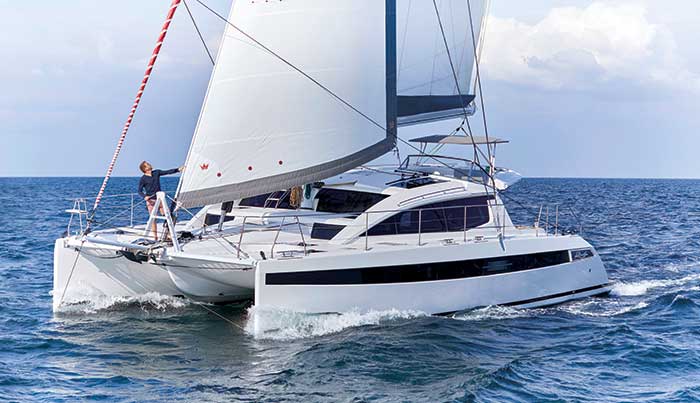
This 43-foot cat is trimmed well for upwind sailing. But once main and boom are eased out to accommodate wind direction, the jib may create a pinched slot as jib tracks are located on cabin tops. (Photo: Privilège Catamarans/Nico Krauss)
As a freelance marine journalist with a U.S. Coast Guard 100-Ton Master license, I get to captain dozens of boats of various designs and sizes. I'm also a cat convert from monohull boating with plenty of firsthand knowledge to share. If you're thinking of chartering or buying a cat, you'll benefit from their inherent advantages. Cats offer more room than the same-lengthmonohulls, they usually have better system access, and sailing cats may be faster in light wind because they're not dragging a heavy keel through the water.
Cats operate upright so you won't be on your ear in a blow. You can cook and sleep on a passage without "walking on the hull" like in a monohull that's heeling. You also spend more time above the waterline on a cat rather than the dreaded "down below" on a monohull.
Of course, for all the pluses, there are minuses: Finding a marina berth for a cat is difficult and expensive. Unlike monohulls that get into the groove and slice through waves when sailing upwind, cats can slap the water if the bridge deck clearance is low, or when the seas meet the underside of the bridge deck.
People who usually sail monohulls may be accustomed to being alerted to the wind rising too much by the increasing heel of the boat. If you get this amount of heeling in a cat, you may be beyond the point of no return; though this isn't as likely with many of today's heavier, wider models. Cats are not self-righting; you have to stay alert to worsening weather.
Also, unless it's a performance model with daggerboards, a cat only has mini-keels, so it won't point high and can be a bit like maneuvering a shoebox. They don't track well, tending to slip to leeward, and they tack slowly because they have to push two hulls rather than one through the eye of the wind. Finally, cats have fairly shallow rudders, so close-quarters maneuvering comes more from dual engine thrust, rather than the water flowing over the rudders — effective, but something to get used to.
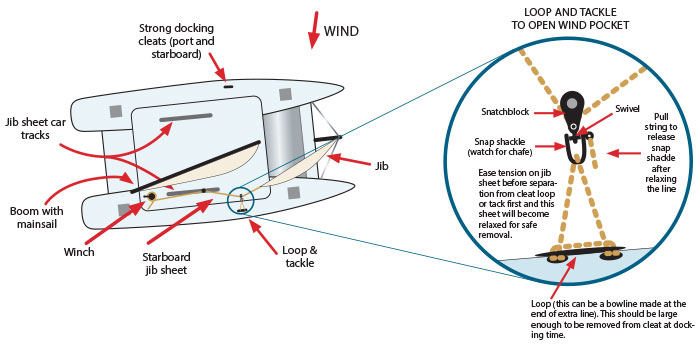
An easy adjustment to position the jib out farther and improve performance is shown in this illustration.
When it comes to the emerging power-catamaran trend, driving cats under power is a straight-up joy. Their two props are set wide apart resulting in much better control and precise maneuvering in close quarters. Cats don't coast like monohulls because they don't have a keel to keep them tracking, so gliding into a dock at a shallow angle doesn't work, and neither does using propwalk to tuck in the stern. You use the engines to spin a cat in its own length or walk it sideways, both of which are easier to master than the nuances of driving a monohull.
Regardless of whether you're docking, picking up a mooring, or anchoring, always keep the boat powered up and ready to drive until you're done because you can't just push a 45-foot cat around by hand. Here are some handling tips that apply to handling both sail and power catamarans.
Don't Ding The Dock
When there's no wind, bigger sailcats also have an engine, which is needed in each hull. They aren't powered to drive as fast, but the principles are the same. Keep in mind, boats and conditions are varied, so we can only give examples here.
- Forget about the wheel when docking side-to or forward. Lock it on the centerline with the wheel lock or by leaning your body against it and maneuver using the throttles (see illustrations below). Power forward with the starboard engine, and aft with the port, and the cat moves to port and vice versa. Turn this around in your head when in reverse. Fine tune adjustments by using one engine at a time. Pause the propeller in neutral when changing directions from forward to reverse and vice-versa to give transmissions time to engage.
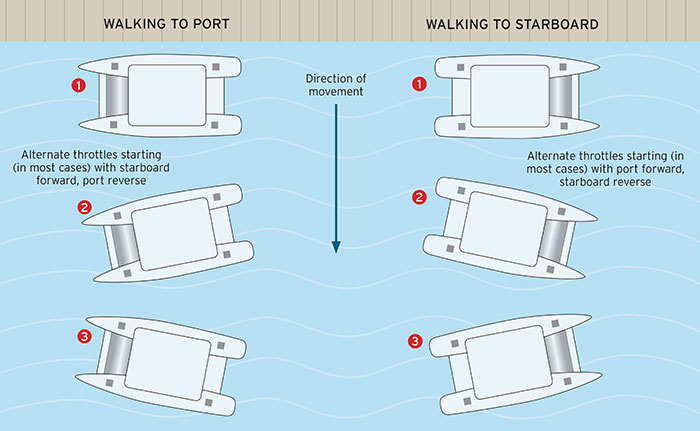
- Backing into a slip: Cats dock stern-to because the bows are high and it's easier to step on and off the dock via the swim platforms aft. When backing straight into a slip, come abeam, pivot 90 degrees with the engines until centered, and back in. If Med-mooring, drop anchor and pay out the rode slowly as you back with both engines. Set the anchor part way back, then keep backing and letting out rode until you're close enough to the dock to tie up the stern lines. Have fenders already tied aft to cushion the transoms. Tighten up on the anchor rode with the windlass.

Wind And Current
As with any boat, it's best to work against the current for better control.
- When departing a starboard tie-up with the current coming at the bow, put a fender and line on the starboard aft corner, power aft with the port engine, pivot, then drive out forward with both engines against the current. If the current is coming from behind, back out, putting a line and fender on the starboard bow. Power in reverse with the starboard engine, pivot, and then back out with both engines.
- Cats have high cabin tops, producing lots of windage. In tight quarters, you may need to turn more sharply when approaching a dock or line up to windward before backing in.
Picking Up A Mooring
Cats have high hulls and it's easy for the skipper to lose sight of a mooring ball before the boat is close enough for the crew to pick it up. Keep the mooring on the side where you can best see forward so you can keep an eye on the ball at all times. (Some cat helm stations are offset to one side or the other.)
- Hand signals or a headset for you and the crew make communications easier to send and receive rather than yelling.
- Have your crew pick up the mooring with a boat hook while you maneuver with the engines to keep station — easier on a cat than a monohulls, even in wind and current.
- Have lines ready by stringing one off a cleat on each hull. To do this, thread each line through the eye or loop, then back onto its cleat. Do this with both sides and adjust until the mooring sits on the centerline. This will minimize swinging and chafe, and noise in the forward cabins.
Anchoring is generally easier on a cat than a monohull. There's more room forward for crew to work, and you can keep the boat steady with the engines.
- A bridle should be preset with a line from each hull (under the trampoline) and hook or shackle in the middle. Once the anchor and chain is down, attach the bridle to the chain (usually done near the windlass) and set the hook putting the pressure on the bridle. Once set, let out enough chain to create a catenary.
- When raising anchor, take care to keep the chain in between the bows or you risk damaging the fiberglass by shaving the bottom of one or the other if you overrun the chain or lose track of where it is. Crew communication is critical.
Sail-Specific Cats
Here's how to coax the best out of a sailing catamaran:
- Big cats carry huge mainsails, so raising one typically requires an electric winch. It also may be challenging to keep full battens out of the lazyjacks that hold up the sail bag, so it can take a few people to raise a large sail. Also, there are usually multiple angles to the way halyards are run on cats with flybridges, resulting in friction. So "dropping" the mainsail can be more like "pulling" it down. Attach a messenger-type line to the mainsail head so it comes down easier.
- Reefing can be a guessing game because you don't feel a cat being overpowered like you do a monohull. Depending on the direction of sail and the sea state, you may be able to reef a little later with the wind a few knots higher — an individual call.
- Cat headsail tracks are typically on the cabin top making the sail curve back on itself, creating a wind break when it's sheeted in. A trick is to bring a spare line from the jib clue out to a cleat on the side deck to open up the slot to let air flow through. Check for chafe on the cabin and don't forget to release it before tacking.
- The majority of multihulls are built to sail on a beam or broad reach, and that's where they're the happiest. Dead downwind, cats shimmy a little making wing-on-wing sailing tricky, not all that different from monohulls. For more comfort, choose one broad reach or the other, then jibe when necessary.
- Cats with daggerboards can point higher and track better because, like monohulls, they have an appendage (or two) down low in the water for a better center of lateral resistance. Daggerboards are mostly used when sailing upwind, and it helps to keep the leeward board lower than the windward one. Sailing downwind with the boards lowered could create a tripping hazard, especially in rough seas where it's possible to stuff the bows into the wave ahead. When motorsailing, a trick to saving fuel and pointing higher is to run only the leeward engine for a little pointing assist.
Next time you have an opportunity to test drive a power or sailing cat, or to charter one on your next holiday, try it! The learning curve is so quick, it's really fun, and before you know it, you, too, may convert to being a cat person!
Catamaran Brands
You can further explore the array of catamarans, big and small, power and sail, by visiting any of these leading manufacturers.
- Aquila Power Catamarans
- Aspen Power Catamarans
- Fountaine-Pajot
- Horizon Power Catamarans
- Leopard Catamarans
- Nautitech 47 Power
- Balance Catamarans
- Fountaine Pajot
- Outremer Catamarans
- Seawind Catamarans
Related Articles
The truth about ceramic coatings for boats.
Our editor investigates the marketing claims of consumer-grade ceramic coatings.
Fine-Tune Your Side Scan Fishfinder
Take your side-scanning fishfinder off auto mode, and you’ll be spotting your prey from afar in no time
DIY Boat Foam Decking
Closed-cell foam flooring helps make boating more comfortable. Here’s how to install it on your vessel
Click to explore related articles
Zuzana Prochazka
Contributor, BoatUS Magazine
Zuzana Prochazka is a freelance journalist specializing in writing, editing, and photography in boating and travel publications. She writes for a dozen boating magazines and websites and a growing list of travel publications. She enjoys combining her passions, which include seeing the world, sailing the oceans, and sharing her experiences through the written word. She holds a U.S. Coast Guard 100 Master license.
BoatUS Magazine Is A Benefit Of BoatUS Membership
Membership Benefits Include:
Subscription to the print version of BoatUS Magazine
4% back on purchases from West Marine stores or online at WestMarine.com
Discounts on fuel, transient slips, repairs and more at over 1,200 businesses
Deals on cruises, charters, car rentals, hotel stays and more…
All for only $25/year!
We use cookies to enhance your visit to our website and to improve your experience. By continuing to use our website, you’re agreeing to our cookie policy.

How To Sail a Small Catamaran (Complete Guide)
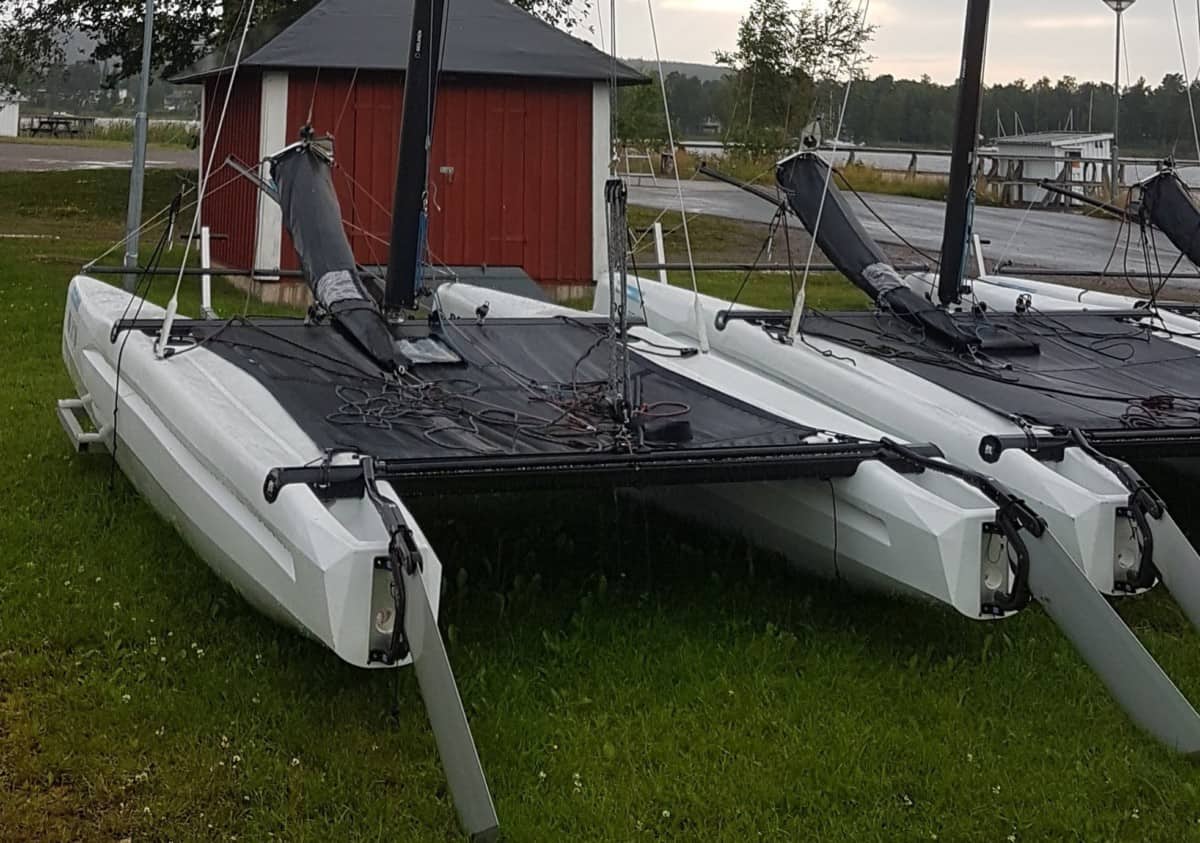
As an Amazon Associate, we earn from qualifying purchases. We may also earn commissions if you purchase products from other retailers after clicking on a link from our site.
Learning how to sail a small catamaran(also known as beach cats) can be the beginning of a new and exciting chapter in your life. It gives you the freedom to comfortably explore the waters, which offers a stimulating and relaxing sensation. If you’re interested in learning how to sail, it is advisable to start with a small catamaran.
To sail a small catamaran (beach cat), first, familiarize yourself with the catamaran’s essential parts and common sailing terminologies. Understand how it works and equip yourself with the necessary sailing gear. Additionally, you’ll need to understand the points of sail, how to steer, turn, and stop the cat.
This guide outlines what you need to know about sailing a small catamaran. Read on to learn more on:
- What is a catamaran?
- Understanding how a catamaran works
- Getting equipped
- Sailing basics
Looking to buy a small catamaran? Read my article Best Catamarans For Beginners
Table of Contents
Understanding a Catamaran
The first step in learning how to sail a small catamaran is to understand its essentials. We begin by looking at what a catamaran is, its essential features, and some standard sailing terms. Understanding the necessary parts of a cat and sailing terminologies helps with communication when sailing.
What Is a Catamaran?
A catamaran is a famous multi-hulled water vessel that features two parallel hulls and sails. Catamarans vary in size and shape, depending on the model and design. However, here we’re looking at the small catamarans (a.k.a. beach catamarans) and how to sail them.
Parts of a Small Catamaran
Below are the essential parts of a catamaran regardless of its model or design:
- Hull : It is the main body of the cat. It has a symmetrical shape, which reduces the drag caused by water friction.
- Tiller : It is a handle or bar that turns the catamaran’s rudder.
- Rudder : An underwater vertical moving board often turned using a tiller (or steering wheel) to initiate movement.
- Keel : It is a centreline attached below the hull running from the front (bow) to your cat’s back (stern). The keel offers stability to the cat and reduces the chances of it capsizing.
- Mast : A long pole set upright from the center of the boat to support the sails.
- Mainsail : It is the most critical sail on a cat that is attached to the mast.
- Foresail : Also known as the jib. It is a sail that fits into the foretriangle of the mast.
- Boom: This is a horizontal pole attached to the mast used for extending the foot of the mainsail.
A full interactive guide on catamaran parts explained ?

Common Sailing Terminologies
Now let’s look at some terms to add to your sailing vocabulary.
- Point of sail : The direction of your cat relative to the wind.
- Port : When facing forward, your cat’s left side is referred to as the port.
- Starboard : Refers to anything to the right of your cat when you are facing forward.
- Bow/ stern : The front and back of the catamaran, respectively. Additionally, you can refer to the bow as ‘forward’ and the stern as ‘abaft/ aft.’
- Tack: Changing the direction of your cat by turning the bow through the wind.
- Jib (gybe): Turning the stern of your cat through the wind to change direction.
- Heeling: A situation where the wind pushes your cat as it leans over in the water.
- Windward: The side of your catamaran that is closest to the wind. It can also be defined as the direction upwind from the point of reference.
- Leeward: The side of your cat far away from the wind. It is the direction of a cat upwind from the point of reference.
- Aboard: On or within the catamaran
- Halyards : Ropes used in raising or lowering the sails on the mast.
- Sheets: Are ropes that control the angle of the sails relative to the wind’s direction.
- Tacking vs Jibing Explained
Learning How a Small Catamaran Works
After gaining knowledge of parts of a cat and the common sailing terms, the next step is to understand how the catamaran works. Here, we’ll look at how the wind gets your catamaran moving.
As the sail of your small catamaran fills with wind, it forms an airfoil that propels your cat. Your sails play the most significant role in keeping your cat moving. As a result, you have to pay much attention to their positioning relative to the wind.
You start by raising the sails using the halyards. The mainsail (the sail closest to the stern) should be raised first, followed by the jib (the sail closer to the bow). With your sails raised, you should then trim them relative to the direction of the wind. By trimming your sails, you position them at an angle where they capture more wind.
As a newbie, you should first learn raising and trimming the mainsail before the jib because you will use it more when sailing your small catamaran.
However, you should note that you don’t rely solely on the sails and the wind to get your catamaran moving. You should also use the tiller to move and control the rudder. This way, you will be in a position to angle your cat in your preferred direction.
As you continue sailing, the wind’s direction keeps on changing. As a result, you should use sheets to trim your sails while tacking and jibing with respect to the wind’s direction changes.
Getting Equipped
After learning how a catamaran works, you are a step closer to practicing in the waters. However, before this, you need to prepare yourself by getting the right sailing gear. Your instructor should advise you on the right clothes and safety equipment.
Here are some items you should not leave behind:
- Shoes : You’ll need a pair of fitting shoes that you can comfortably use on the deck. They should be grippy and non-marking.
- Gloves : It is also advisable to have quality sailing gloves. They should be comfortable to wear and also allow you to control the tiller and perform other duties on board. Consider getting heavy-duty and breathable gloves.
- Sunglasses: You’ll also need good polarized sunglasses that will protect your eyes from the glare. When learning how to sail, it is essential to see how the water is moving. This helps in learning how to read the wind.
- Windbreaker : Do not forget a piece of clothing that will keep you comfortable even under windy conditions. It should be warm and waterproof.
- Logbook: You’ll also need a book where you can keep all your sailing records. You can indicate how many sailing classes you’ve taken, the number of hours you’ve sailed, and the waters, shallow or deep.
- Compass / GPS : Don’t leave behind a compass and a map. These come in handy when you want to find a bearing or are lost in the sea.
- First aid kit : When packing your essentials, don’t leave behind a first aid kit. As a newbie, you might have sea sickness during your first sailing sessions. Carry a kit with the right prescriptions.
- Finally, do not leave behind a phone and a power bank, plus enough food and water.
After preparing yourself for sailing, you should also prepare your small catamaran.
Preparing the Catamaran
Preparing your beach catamaran for sailing involves analyzing its parts and studying the prevailing weather conditions.
Perform a Physical Check
First up, conduct a detailed physical check to see if all the parts are in their stable working conditions:
- Check if the tiller is moving freely to control the rudder.
- Look at the condition of your sails. Ensure they are straight and with no holes or frayed edges.
- The rigging should be in their perfect working conditions. Check the standing rigging (everything that keeps the mast and sails upright) and the running rigging (the lines used to raise and control the sails).
- Check all lines . They should be free. This means they should not be wrapped against each other or around any objects aboard. Here you may also need to tie line knots if you intend to use them during your sail.
Study the Wind
Before getting into the waters, you’ve to study the direction of the wind. Knowing how the wind is blowing helps in the proper positioning of the sails and the cat. You can check the wind’s direction by looking at wind instruments in your small catamaran.
Most catamarans have wind indicators strategically placed on their mast. You can use this. Additionally, you can tie small flags on the sides of your cat to help with the direction. Knowing where the wind is coming from allows you to position your cat at the right point of sail.
Points of Sail
The point of sail defines the direction of the wind relative to your cat. With the right point of sail, you will be in a position to sail your catamaran smoothly. The point of sail differs depending on the angle of your cat from the wind. The different points of sail include:
- Running : In a running point of sail, the wind blows behind your back. It is not advisable to use this point of sail as accidents are prone to occur if the wind’s force pushes over your small cat.
- Broad reach : The wind is partially at your back and your side (aft quarter).
- Close reach : Here, you are sailing at approximately 60-75 off the wind.
- Beam reach : You position your cat at an angle of 90 of the wind. It is considered the most precise sailing position.
- Close haul : At this point of sail, you are approximately 45-60 off the wind.
Hoisting the Sails
Now that you have already identified the wind’s direction and positioned your cat, the next important thing is hoisting the sails. While hoisting your sails, it is advisable to start with the mainsail.
- To start with, secure the bottom front of the mainsail to the respective shackles on the boom.
- Notice a small line known as an outhaul that attaches the clew (the lower back part of the mainsail) to the boom. Carefully pull it out until the mainsail forms a smooth airfoil allowing wind to blow over it.
- Now pull down the halyard until it stops . You will notice some flapping on the mainsail, which is normal.
- Ensure that the mainsail’s edges are smooth , then attach the halyard on the winch or cleat.
- Now shift to the jib and hoist it . Start by securing its bottom front part to the boom and then follow a process similar to that of hoisting the mainsail.
Start Sailing
As a newbie, you need to ensure you are on a safe sailing point during your practice sessions. Avoid going far into the waters with your small catamaran during your first training sessions.
Also, ensure that you have enough space around you for your catamaran to turn in response to the wind movements. This is to avoid being thrown back into the dock or in the sand by the moving wind.
As you start sailing, you’ll notice the effects of the wind on your cat. As a result, you may need to make a turn through tacking or jibing .
When sailing, always make sure you place yourself at the right point in your catamaran. Sit at the side where the wind is blowing to; the wind should blow from your back. This means you should be on the opposite side of the sail and not beneath it. Sitting on the wrong side might cause your cat to flip over.
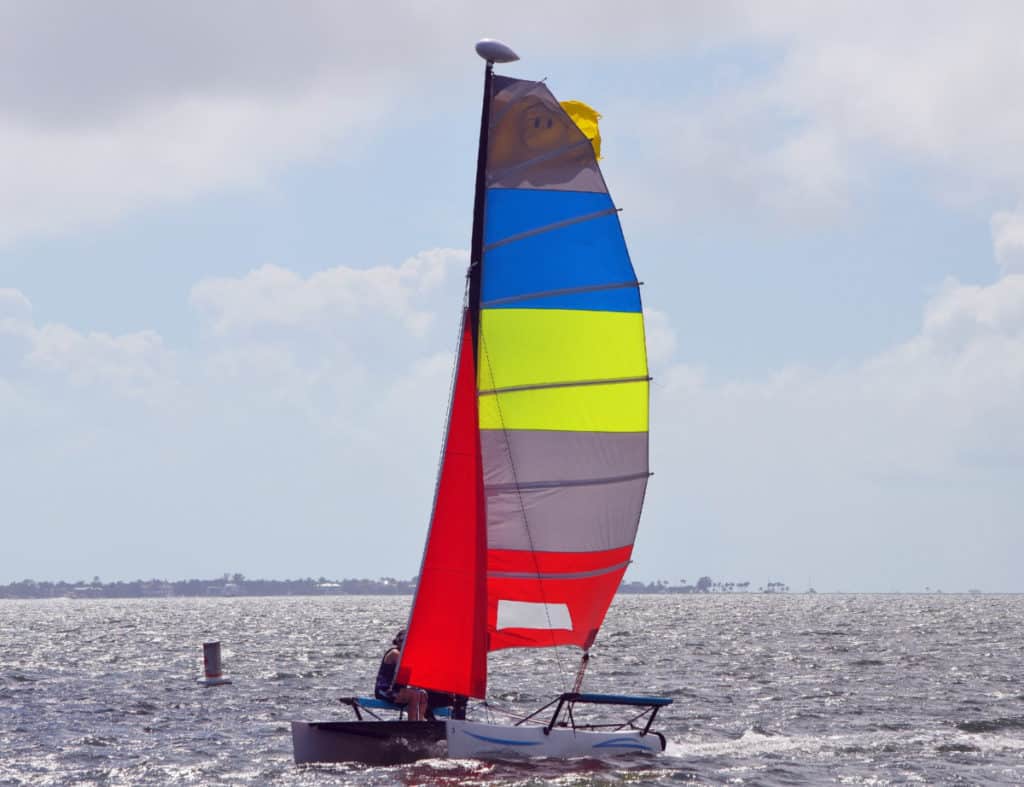
Now that you already know how to get your cat moving, let’s look at steering. Steering the cat is often unclear to most newbies.
Small catamarans are steered using a tiller that controls the rudder. What confuses most sailors is that you move the tiller in the opposite direction from which you want your cat to move. So, if you’re going to turn to the right, you will push your tiller to the left and vice versa.
Since steering a small cat differs from steering other moving vessels, the experience may feel awkward at first. However, you shouldn’t feel pressured to master it all at once. Take your time and practice until you master the process.
Trimming the Sails
As you continue learning how to sail, you also need to understand how to control your cat by trimming sails. Trimming sails means adjusting the positioning of your sails to control the movement of your cat.
As a learner, to effectively and safely trim your sails, you should first position your tiller to reduce the movement of your cat to either side. Start by trimming the mainsail.
Tighten the mainsail to stop flapping and for it to take a new shape relative to the wind’s direction. As your mainsail takes a new form, your cat will start building some speed. Quickly grab the jib and adjust it too.
To tighten the jib, stretch it as much as you can to reduce flapping/ luffing. Once the flapping has reduced, loosen it and let it out until the edge of its luff (the forward end of the jib) is shaking. Now tighten it back in its new position, and you are ready to go.
If you are sailing close to the wind, you have to keep your sails tighter than usual. On the other hand, if you are sailing off the wind, your sail should be left loose. Generally, tight sails cause your cat to move faster, while the opposite is true for loose sails.
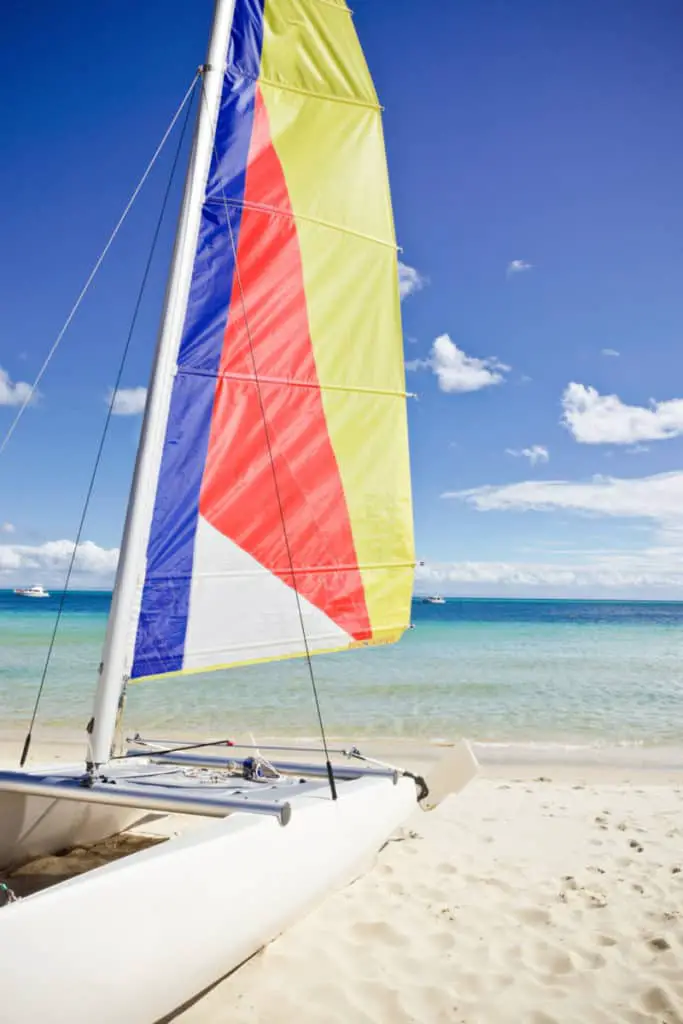
Turning the Catamaran
You’ll also need to learn how to turn a catamaran. As a learner, after releasing the mooring line, you should be prepared to turn the catamaran by moving the boom to either side. As you push out the boom, the wind will hit your sail from the back, making your cat turn.
Therefore, you should be cautious enough to avoid turning in the wrong direction. Like in moving the tiller, you also push out the boom into the opposite direction you want to turn. Therefore, when turning to the right, you push out the boom to the left and vice versa.
Slowing Down and Stopping
Although sailing a small catamaran at high speeds is fun, you may at some point want to slow down. When you detect an obstacle in the water, you may need to slow down. Most sailors use the term ‘spill wind’ to refer to the action of slowing down and stopping a cat.
Since tighter sails often accelerate the speed of your cat, you can slow it down by loosening them a little. The more you let your sails out, the more your cat slows down and eventually stops.
It is advisable to release the sails as you face the wind’s direction to help your cat stop. If you are sailing against the wind, first turn your cat in the direction of the wind, then release the sails.
Practice slowing down and stopping your cat under different weather conditions to be prepared in case of an emergency. Since your cat has no brakes, you should practice this until you perfect your skills.

Capsize Recovery
Although capsizing is not common in catamarans, it can happen and it is crucial always to be prepared. If your small catamaran capsizes, it is advisable to start the recovery process immediately before the situation worsens. Let’s look at how to right a capsized catamaran.
Why and how often do catamarans capsize, a scientific approach!
You can right most small catamarans by pushing the bow or stern below the water to rotate them upright.
To right your capsized catamaran:
- Lower down your bow and stern until your cat lies in a vertical position.
- One crew member should then swim around to one end of the lower hull and then push it down. By pushing the lower end down, the uppermost hull’s end comes down towards the water.
- As the uppermost hull drops towards the water, it is pulled down by another crew member. In the meantime, the other crew pushes the cat up midway along the lower hull.
- This movement puts your cat in a vertical position in the water. The crew members then swim to the mast and push it back to its standard sailing position. They then climb aboard fast before the cat sails off.
Avoid sailing alone. Always have some crew members to help you out in case of a capsize.
Learning how to sail a small catamaran is a process that requires practice and patience to perfect your skills. Therefore, don’t feel pressured; take it slow, a step at a time. Start by understanding the essentials of a catamaran, preparing yourself and your cat for the adventure, and learning some sailing basics.
The fundamental sailing basics outlined in this guide are the points of sail, steering, trimming sails, slowing down, and righting a cat after a capsize. Follow our guide today and become a pro in sailing a small catamaran.
- Catamaran Parts Explained
- Why do catamarans capsize?
Owner of CatamaranFreedom.com. A minimalist that has lived in a caravan in Sweden, 35ft Monohull in the Bahamas, and right now in his self-built Van. He just started the next adventure, to circumnavigate the world on a Catamaran!
Leave a Reply Cancel reply
Your email address will not be published. Required fields are marked *
Save my name and email in this browser for the next time I comment.
Recent Posts
Must-Have Boat Gear for Catamaran Sailors!
Sailing is probably the most gear-intensive activity I've ever done; there are so many decisions to be made about what gear to buy now, for tomorrow, and what to definitely never buy. The gear on...
6 Best Trailerable Trimarans For Bluewater and Coastal Sailing
Having a boat costs a lot of money, even when you are not using it, marina fees, etc. And once it is in the water most sailors never go very far from their "home marina" and sailing will be somewhat...

- BOAT OF THE YEAR
- Newsletters
- Sailboat Reviews
- Boating Safety
- Sails and Rigging
- Maintenance
- Sailing Totem
- Sailor & Galley
- Living Aboard
- Destinations
- Gear & Electronics
- Charter Resources

From the Archives: Trimming a Cat’s Mighty Main
- By Herb McCormick
- Updated: September 23, 2015

There are certain inalienable truths about trimming the mainsail aboard any cruising boat. The main halyard must be taut enough at all times to eliminate excessive wrinkling in the luff of the sail (though it may be lowered or raised an inch or two depending on the wind strength). You always want the leech of the sail firm and unflappable (some, but not all, mainsails have a dedicated leech line for this purpose). And the sail’s leech telltales should be streaming aft in unison.
Those basic rules apply to all mainsails, whether on a monohull or a multihull. But when it comes to fine-tuning the trim depending on the point of sail, there’s a subtle but important difference between a modern single-hulled sailboat, where boom vangs and backstay tension play a crucial role, and a contemporary catamaran or trimaran, with its generous roach supported by a series of full battens (which must be properly tensioned to ensure optimum shape and draft).
To put it in the simplest of terms, on a monohull, it’s all about the mainsheet. On a catamaran, it’s all about the traveler.
There’s a good reason that cats employ wide, easily adjusted travelers. They’re the primary tool for trimming the main. On a catamaran sailing upwind, the mainsheet should be cinched home and the boom positioned just slightly leeward of centerline—just like on a monohull. But as you crack off, instead of first dropping the traveler and then easing the mainsheet, as you would on a mono, resist the urge to trip the mainsheet and only ease the traveler, always keeping an eye on those flowing telltales. Continue doing so even when bearing off to a beam reach and beyond. Only then should you begin to ease the mainsheet, and always in small increments. Remember: Watch those telltales.
There are several reasons why you trim the main differently. On a monohull, in concert with the mainsheet and traveler, you have the vang to help control the position of the boom; on a multihull, the mainsheet serves the same purpose. The last thing you want on a multihull is a boom bouncing skyward on any sort of reach, from close to broad, which destroys the shape and efficiency of the sail.
Also, in puffs, aboard a multihull the apparent wind will move forward and affect the sail trim as it does so. Rather than spin the wheel and bear away, just crank in the traveler.
On monohulls, excessive heeling is a sure sign that something’s amiss. On level-sailing cats, an unbalanced boat isn’t always so easily detected; you’ll know you’re overpowered when the helm loads up. Again, lower the traveler or, if it’s already all the way down, ease the mainsheet. The next step, naturally—as it would be on a monohull—is to shorten sail and take a reef in the main.
Over time, of course, as you sail any new boat and log a few miles, matters like sail trim and balance become instinctual and almost second nature. But if you’re a rookie on a catamaran, remember two things: Telltales never lie, and the traveler is your best friend.
Herb McCormick is CW’s senior editor.
- More: catamaran , How To , multihull , sailtrim , seamanship
- More How To

DIY Tips for Repairing Nonskid

Shaft Bearing Maintenance Tips

When the Wind Goes Light

How We Built Our Own Bulwarks

Hurricane Beryl Relief Efforts: How You Can Help

Gary Jobson To Talk U.S. Prospects in Upcoming World Sailing Competitions

For Sale: 2005 Tayana 48

Make Downwind Sailing Fun Again. Turn Off That Motor and Unfurl Your Kite!
- Digital Edition
- Customer Service
- Privacy Policy
- Email Newsletters
- Cruising World
- Sailing World
- Salt Water Sportsman
- Sport Fishing
- Wakeboarding

Mastering Catamaran Sailing: Essential Guide & Tips to Navigate the Waters
Alex Morgan
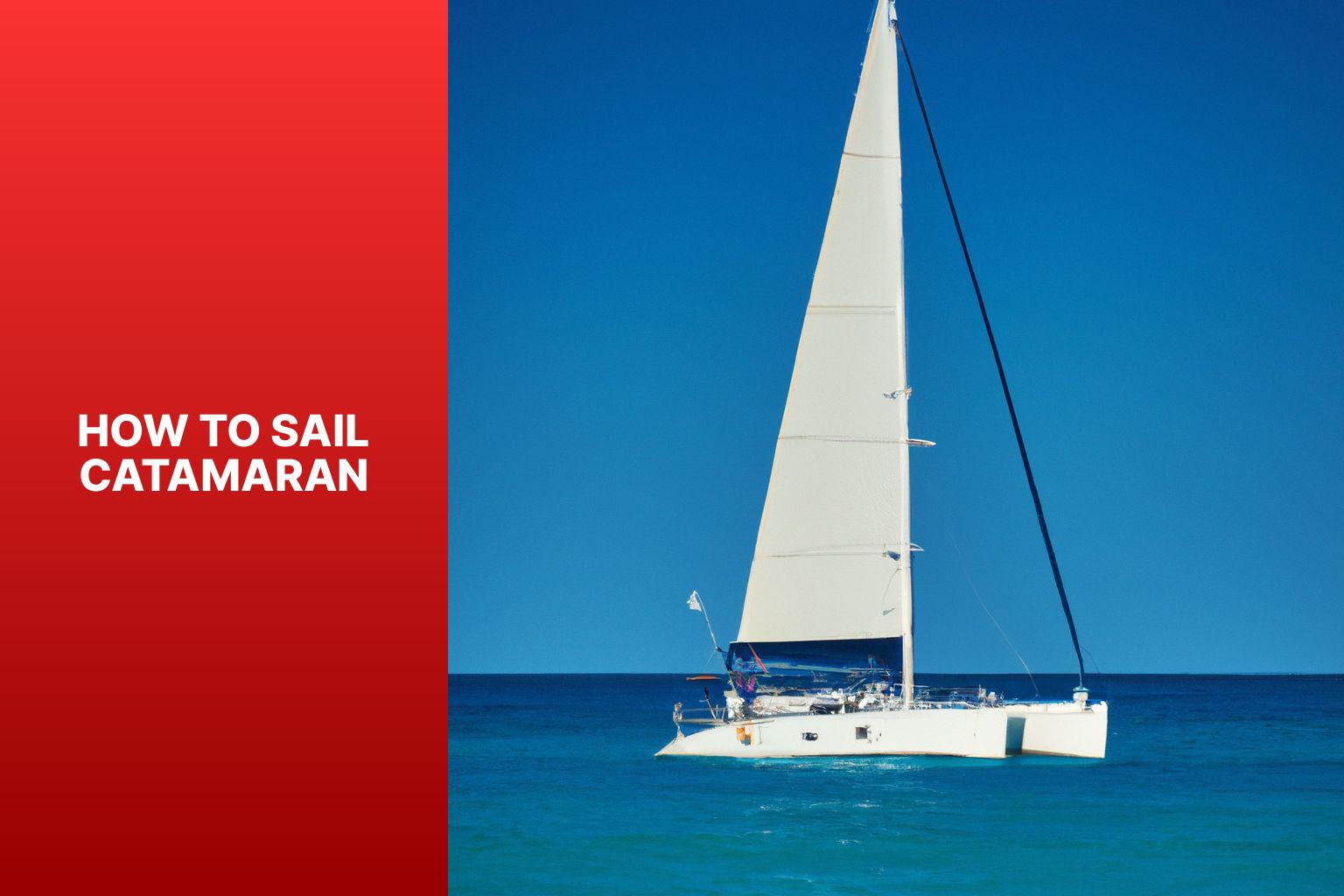
Sailing a catamaran can be an exhilarating and enjoyable experience for both experienced sailors and beginners alike. Unlike monohull sailboats, catamarans offer unique advantages in terms of stability and speed. If you’re interested in learning how to sail a catamaran, it’s important to understand the basics and master the necessary skills. This article will provide you with a comprehensive guide to sailing a catamaran, from understanding the fundamentals to maneuvering and handling the boat effectively.
To begin with, let’s delve into the introduction of sailing a catamaran, followed by understanding the basics of a catamaran. We’ll explore what exactly a catamaran is and how it differs from a monohull sailboat. we’ll discuss the advantages of sailing a catamaran, highlighting why it has become a preferred choice for many sailors.
Before setting sail, proper preparation is essential. This section covers the importance of safety equipment and checks, along with understanding wind and weather conditions. Planning your route is crucial to ensure a smooth and enjoyable sailing experience.
Once you’re prepared, we’ll move on to the essential sailing techniques for a catamaran. This section will guide you through rigging and hoisting the sails, tacking and jibing, trimming the sails, and controlling speed and direction. Mastering these techniques is key to maneuvering the catamaran effectively on the water.
Handling the catamaran also requires specific techniques. We’ll cover important maneuvers such as docking and undocking, mooring and anchoring, and addressing emergencies like man overboard recovery. These skills are vital to ensure a safe and successful journey.
We’ll provide you with essential safety tips for sailing a catamaran. Understanding right-of-way rules, handling rough seas and heavy winds, and maintaining balance and stability are crucial aspects of staying safe on the water.
By the end of this comprehensive guide, you’ll have a solid understanding of how to sail a catamaran and be well-equipped to embark on your own catamaran adventures while ensuring a safe and enjoyable experience.
– Sailing a catamaran offers the advantage of maximizing space with its two hulls, allowing for more comfortable living quarters and a larger deck area. – Catamarans provide a stable and balanced sailing experience, making them a safer option for beginners and those prone to seasickness. – Proper preparation, including checking safety equipment, understanding weather conditions, and planning your route, is crucial for a successful catamaran sailing experience.
Understanding the Basics of a Catamaran
Understanding the basics of a catamaran is essential for safe and enjoyable sailing. A catamaran is a boat with two parallel hulls connected by a deck. It has advantages over monohull boats. Catamarans are stable due to their wide beam, reducing the risk of capsizing . They can access shallow waters because of their shallow drafts . Catamarans also offer more space and comfort with larger cabins, living areas, and deck space.
To control a catamaran, the skipper uses the helm to control the rudders. Adjusting and trimming the sails allows the skipper to use the wind’s power and steer the boat efficiently. Balancing the sails and maintaining stability while sailing is important.
Knowing the key components, how to control the boat, and handle the sails will help you navigate the waters confidently. Whether you’re a seasoned sailor or a beginner, familiarizing yourself with the fundamentals of catamarans is crucial.
What Is a Catamaran?
A catamaran, also known as a cat , is a type of boat that features two parallel hulls connected by a platform or bridge deck. This unique design provides it with stability and speed, making it a popular choice for sailing enthusiasts. Unlike traditional monohull sailboats, a catamaran offers a wider beam , which results in more space and greater stability . As a result, the sailing experience on a catamaran is smoother and more comfortable .
There are several advantages to sailing a catamaran. One significant advantage is its shallow draft , which allows it to navigate in shallower waters that are inaccessible to other types of boats. The dual hull design of a catamaran minimizes drag and enhances speed , making it highly efficient for long-distance cruising . The spacious interior layout of a catamaran provides ample room for accommodations , amenities , and storage .
When sailing a catamaran, it is essential to consider the wind and weather conditions for safe navigation. Understanding the right of way rules and knowing how to handle rough seas and heavy winds are crucial skills for catamaran sailors. Maintaining balance and stability is of utmost importance to ensure a smooth sailing experience.
A fun fact about catamarans is that they have been utilized by Polynesian cultures for centuries, proving their effectiveness and versatility in various sailing conditions.
How Is a Catamaran Different from a Monohull Sailboat?
A catamaran is different from a monohull sailboat in several ways. A catamaran has two parallel hulls connected by a deck or bridge, whereas a monohull sailboat only has one hull. This dual hull design provides greater stability and balance on the water.
In addition, the hulls of a catamaran are wider and shallower compared to those of a monohull, allowing for a shallower draft and improved maneuverability . This also results in a higher cruising speed and faster sailing speeds for catamarans.
Catamarans also offer more interior space and are known for their spaciousness and comfort , thanks to their wider beam. When sailing upwind, catamarans experience less heeling , which translates into a smoother and more comfortable ride for passengers.
Catamarans are better suited for cruising in shallow waters and can anchor closer to shore due to their shallow draft . The dual hull design of catamarans also provides greater redundancy and safety in the event of hull damage or collision.
Unlike monohull sailboats, which typically have a keel, catamarans rely on centerboards or daggerboards to prevent sideways sliding. The main differences between a catamaran and a monohull sailboat lie in their stability , speed , comfort , and maneuverability .
Advantages of Sailing a Catamaran
– Stability: Catamarans offer excellent balance with their twin hulls, making them less likely to tilt or capsize compared to monohull sailboats.
– Spaciousness: The wide beam of catamarans provides more interior and deck space, including comfortable living quarters, larger cabins, and ample room for socializing and entertaining.
– Speed: The design of twin hulls reduces drag, allowing catamarans to sail faster and provide exhilarating experiences.
– Shallow Draft: Catamarans have a shallower draft than monohull sailboats, enabling them to sail in shallower waters and access a wider range of cruising grounds.
– Comfort: The wide beam and stable design of catamarans offer a smoother and more comfortable sailing experience, eliminating the heeling common in monohull sailboats and reducing the chances of seasickness.
– Maneuverability: Catamarans are more maneuverable than monohull sailboats, providing better turning ability for navigating tight spaces, docking, and anchoring precision.
– Sailing Performance: Catamarans excel in light wind conditions, thanks to their large sail area and light weight, allowing them to catch even the slightest breeze and maintain good boat speed. This makes them ideal for destinations with calm weather patterns.
Preparing for Sailing a Catamaran
Preparing for a thrilling catamaran sailing adventure requires careful planning and essential knowledge. As we dive into the section on “ Preparing for Sailing a Catamaran ,” we’ll explore vital aspects such as safety equipment and checks , understanding wind and weather conditions , and planning your route . Get ready to uncover expert tips and strategies to ensure a smooth and enjoyable catamaran journey on the open waters.
Safety Equipment and Checks
Prioritize safety when sailing a catamaran. Thoroughly check and prepare your safety equipment before setting off on your adventure. Consider the following important safety equipment and checks :
- Life jackets: Ensure enough properly fitting life jackets for everyone on board.
- Flotation devices: Have throwable flotation devices readily available for emergencies.
- Fire extinguishers: Have the appropriate type and number of fire extinguishers on board.
- First aid kit: Maintain a well-stocked kit for handling minor injuries or medical emergencies.
- Navigation lights: Ensure all navigation lights are functioning properly, especially for sailing at night or in low visibility conditions.
- Communication devices: Carry reliable communication devices such as a marine VHF radio or satellite phone for calling for help if needed.
- Engine and safety equipment checks: Regularly inspect engines, bilge pumps, anchor systems, and other safety equipment to ensure good working condition.
Remember, safety is crucial. Check your safety equipment before every trip and ensure proper working order. Familiarize yourself with specific safety requirements and regulations of the sailing area. By taking these precautions, you can enjoy your catamaran sailing adventure with peace of mind and be prepared for any unexpected situations.
Understanding Wind and Weather Conditions
Understanding wind and weather conditions is crucial when sailing a catamaran. You must have a comprehensive understanding of the wind direction, speed, and weather changes that may impact your sailing experience. Here are some key considerations to keep in mind:
1. Wind direction: It is essential to know the direction from which the wind is blowing. This knowledge will assist you in planning your sailing route and selecting the appropriate sails.
2. Wind speed: Pay close attention to the wind speed as it could potentially affect the speed and maneuverability of your boat. Higher wind speeds may necessitate reefing the sails or adjusting your course.
3. Weather changes: Remain mindful of any approaching storms, rain, or fog. These conditions can have a significant impact on visibility and create challenges when sailing.
4. Sea state: Take note of the current sea state, which includes wave height and frequency. Rough seas may require you to adjust your sailing technique and speed to ensure the stability of the catamaran.
5. Weather forecasts: Always remember to check the weather forecasts before embarking on your sailing trip. This will provide you with an overview of the expected weather conditions.
By possessing a thorough understanding of wind and weather conditions, you can make well-informed decisions to ensure a safe and enjoyable sailing experience aboard a catamaran. Keep in mind that conditions at sea can change rapidly, so it is essential to stay vigilant and adapt your plans accordingly.
Planning Your Route
When planning your catamaran sailing route, it is important to consider several factors for a safe and enjoyable journey. One of the first things to do is assess the weather conditions by checking the forecast for potential storms or strong winds. It is crucial to avoid adverse conditions as they can pose risks to both the crew and the catamaran’s safety.
In addition, it is necessary to identify key destinations and conduct research on navigational challenges. This will help in finding suitable anchorages or marinas along the way. Creating a timeline is also essential to plan the duration of the journey, taking into account the distance to be covered and the catamaran’s speed. It is important to remember to account for any time constraints or events that may affect the plan.
Using navigational charts, it is advisable to plot the course, noting any potential obstacles along the way. It is also a good practice to plan alternative routes in case they become necessary. Considering currents and tides is another crucial aspect of route planning. Studying tidal patterns and current directions will allow for incorporating these factors into the planning process for greater efficiency.
Another important consideration is fuel and provisions . It is necessary to determine the locations of fuel stations and provisioning points along the route. Planning fuel stops and stocking up on supplies will ensure that you have everything you need during the journey. Communication and safety should not be overlooked either. Identifying channels to communicate with other sailors and emergency assistance is vital . It is also important to familiarize yourself with emergency procedures and have access to contact information in case of any unforeseen circumstances.
It is recommended to regularly review your route plan and make adjustments based on real-time conditions and feedback. This will help ensure that you are always up to date with any changes that may occur during the journey. By carefully planning your route, you can optimize your sailing experience, safely navigate waters, and fully enjoy your catamaran adventure.
Essential Sailing Techniques for Catamaran
Mastering the essential sailing techniques for a catamaran is the key to harnessing the power of wind and water. From rigging and hoisting the sails to controlling speed and direction, each sub-section in this guide will unlock the secrets that seasoned sailors swear by. So, get ready to tack and jibe , trim those sails just right, and experience the exhilaration of sailing a catamaran like a pro!
Rigging and Hoisting the Sails
To rig and hoist the sails on a catamaran, follow these steps:
1. Assemble the mast, boom, and rigging securely and properly aligned.
2. Attach the main halyard securely and tensioned to the head of the mainsail.
3. Attach the jib halyard properly tensioned and secured to the head of the jib sail.
4. Connect the main sheet to the boom to control the angle and tension of the mainsail.
5. Connect the jib sheets to the clew of the jib sail to control the angle and tension of the jib sail.
6. Attach the reefing lines to the mainsail, if applicable, to reduce sail area in strong winds.
7. Check all rigging and lines for proper tension and adjustments, ensuring everything is secure and aligned.
8. Raise the mainsail by pulling on the main halyard while guiding the sail up the mast, using winches or other mechanical aids if necessary.
9. Raise the jib sail by pulling on the jib halyard while guiding the sail up the forestay, using winches or other mechanical aids if needed.
10. Adjust the main sheet and jib sheets to achieve the desired sail shape and trim for optimal boat performance.
Rigging and hoisting the sails on a catamaran is crucial for a smooth and exhilarating sailing experience. By following these steps, you can confidently prepare your catamaran for sailing adventures.
Now, let’s appreciate the history of rigging and hoisting sails. Sailing has been a vital mode of transportation and exploration for centuries. The technique of rigging and hoisting sails has evolved from simple square sails to more efficient and versatile fore-and-aft sails used on catamarans. Today, catamarans are equipped with advanced rigging systems and modern materials that enhance speed and maneuverability. Rigging and hoisting sails remain a vital skill for sailors, connecting us to our seafaring ancestors and enabling exploration of the world’s oceans with grace and agility.
Tacking and Jibing
Tacking and jibing are essential maneuvers when sailing a catamaran. These techniques allow you to change direction and make the most of the wind. Consider these key points:
- Tacking: This maneuver is used to sail against the wind. Turn the bow of the boat through the wind to switch the sails to the opposite side. This allows you to zigzag towards your destination.
- Jibing: Use this maneuver to change direction with the wind at your back. Turn the stern of the catamaran through the wind to move the mainsail to the other side. Control the boom to prevent dangerous swinging.
- Preparation: Before tacking or jibing, ensure that the crew is aware and in a safe position for stability during the turn.
- Wind direction: Success with tacking and jibing depends on understanding the wind. Assess the wind and plan your maneuvers accordingly.
- Practice: Perfecting tacking and jibing requires practice. Start with gentle maneuvers in light wind conditions and gradually progress with experience.
During a sailing race, a crew utilized their knowledge of wind patterns and executed a flawless maneuver by tacking right before the finish line. This tactical advantage secured their victory.
Trimming the Sails
Sailing a catamaran requires mastering the skill of trimming the sails . Properly trimmed sails greatly impact the catamaran’s performance and maneuverability. Here are some important considerations for sail trimming:
1. Adjusting the tension: Properly adjusting the tension on the sails is vital for achieving the desired shape and angle. The main sail should have a slight curvature called camber , which generates lift and power. Trim the jib sail to maintain smooth airflow on both sides.
2. Controlling the angle: The angle of the sails in relation to the wind direction is crucial for maintaining optimal speed. Adjust the sheets to trim the sails closer or further from the wind based on sailing conditions and desired speed.
3. Monitoring the telltales: Telltales , small yarn or ribbon pieces attached to the sails, provide valuable airflow information and indicate proper sail trimming. Continuously observe the telltales to ensure smooth and even flow.
4. Reefing: In strong winds, reducing the size of the sails through reefing is necessary to maintain stability and control. Follow the manufacturer’s guidelines for reefing and ensure proper securing of the sails.
5. Constant adjustment: Sail trimming requires constant attention. Continuously monitor wind conditions and make necessary adjustments to optimize performance and maintain control.
Mastering the art of sail trimming leads to smoother sailing, improved speed, and enhanced overall performance on a catamaran. Practice and experience are essential for developing this skill, so head out to the water and start honing your sail trimming abilities.
Controlling Speed and Direction
To effectively control the speed and direction of a catamaran, it is important to follow these steps:
1. Sail Adjustment: Optimize the power and speed of the catamaran by trimming the sails. Utilize the mainsail and jib sheets to manipulate the sail angle, taking into account the wind direction.
2. Utilize the Traveler: Fine-tune the speed and stability by adjusting the traveler. This tool, located across the cockpit, allows you to modify the mainsail sheeting point and control the angle of the mainsail.
3. Sail Plan Modification: Alter the sail plan as necessary to either increase or decrease speed. Reef the sails in strong winds to reduce the sail area, and unreef them in light winds to allow for greater sail area.
4. Daggerboard Adjustment: Maintain stability and control the direction of the catamaran by raising or lowering the daggerboards. These adjustments contribute to achieving balance and maneuverability.
5. Rudder Tweaking: Make slight adjustments to the rudder angle using the tiller or wheel, ensuring smooth steering of the boat.
Pro-tip: Enhance your ability to control speed and direction on a catamaran through practice and experience. Continuously monitor wind conditions and make minor adjustments to optimize performance.
Catamaran Maneuvers and Handling
Get ready to conquer the waters as we dive into the art of sailing a catamaran. In this section, we’ll navigate through the thrilling aspects of docking and undocking , the essentials of mooring and anchoring , and the crucial skill of man overboard recovery . Brace yourself for a wave of practical tips and tricks that will enhance your catamaran sailing experience. So, grab your compass, adjust your sails, and let’s set sail on this exciting journey!
Docking and Undocking
Docking and undocking a catamaran can be daunting, but with the right techniques and precautions, it can be done smoothly. Follow these steps:
- Approach the dock slowly, keeping an eye on the wind and current.
- Assign crew members to handle lines and fenders for a safe docking process.
- Shift into reverse as you near the dock to slow down.
- Turn the helm to steer the catamaran parallel to the dock as you stop.
- Have crew members ready with fenders to protect the catamaran.
- Engage reverse to back closer to the dock, using brief forward bursts to maneuver if needed.
- Once close, crew members should step off the catamaran with lines to secure it to the dock.
- Secure the catamaran using docking lines , ensuring they are properly fastened and have enough slack.
True story: One summer, while docking our catamaran in a busy marina, a strong gust of wind made our docking process challenging. Thanks to our crew’s quick reflexes and knowledge, we maneuvered the catamaran safely and secured it to the dock without damage. It was a valuable lesson in being prepared for unexpected situations while docking and undocking a catamaran.
Mooring and Anchoring
Mooring and anchoring are integral skills when sailing a catamaran. It is important to consider several key points when engaging in these activities. Make sure to choose the appropriate anchor that matches the type of seabed you will be navigating. Inspect the anchor line thoroughly to ensure it is in good condition and securely attached. Next, carefully select a mooring spot in a protected area that offers solid holding ground. When approaching the mooring, take into account factors such as wind and current, and proceed slowly. To secure the boat, use mooring lines that are connected to cleats or deck fittings. Safeguard your boat from potential damage by utilizing fenders . Prioritizing safety and accounting for your boat’s unique conditions and requirements is crucial. By practicing these techniques, you can enhance your proficiency and guarantee a safe and enjoyable sailing experience.
Man Overboard Recovery
- Assess the situation: When facing a man overboard situation, it is important to stay calm and promptly evaluate the circumstances. Take into account the distance between the catamaran and the individual in the water, as well as any nearby hazards or obstacles.
- Alert the crew: Immediately inform the other crew members about the man overboard incident. This ensures that everyone is informed and prepared to provide assistance.
- Initiate the man overboard recovery process: Throw a life buoy or any floating object towards the person in the water, offering them something to hold onto. This will help keep them afloat during the recovery process.
- Turn the catamaran: Skillfully maneuver the catamaran to create a controlled loop or figure eight pattern around the individual in the water. This will slow down the vessel and facilitate their retrieval.
- Bring the person back on board: Once the catamaran is properly positioned, utilize a ladder, swim platform, or any available means to assist in bringing the person back on board. Assign crew members to provide support and ensure the individual’s safety throughout the recovery process.
- Monitor and provide medical assistance: After the person is safely back on board, promptly evaluate their condition and administer any necessary medical attention. Check for injuries, monitor vital signs, and administer first aid if needed.
Pro-tip: Conduct regular man overboard drills and practice recovery procedures with your crew to ensure that everyone is familiar with their respective roles and responsibilities. This will help reduce response time and enhance the likelihood of successfully recovering individuals in emergency situations.
Safety Tips for Sailing a Catamaran
Discover essential safety tips when sailing a catamaran in this section. From understanding right of way rules to dealing with rough seas and heavy winds, you’ll learn how to navigate challenging conditions with confidence. We’ll explore techniques for maintaining balance and stability, ensuring a smooth and secure sailing experience. So hop aboard and let’s dive into the world of catamaran sailing safety !
Understanding Right of Way Rules
Understanding Right of Way Rules is crucial for safe sailing. Follow these guidelines:
1. Sailboats have the right of way over powerboats. Be aware of your surroundings and give way to any sailboats in your path.
2. When encountering a vessel on your starboard side, yield and give them the right of way. Alter your course slightly to avoid a potential collision.
3. When overtaking another vessel, keep a safe distance and give them the right of way. Maintain a slow and steady speed to avoid creating a dangerous situation.
4. In narrow channels or crowded areas, vessels going uphill or against the current have the right of way. Yield to any vessels navigating in these challenging conditions.
5. Always be cautious and maintain a safe speed when crossing paths with other vessels. Slow down if necessary to ensure a safe passage.
By understanding and adhering to right of way rules, you can navigate the waters confidently and reduce the risk of accidents. Remember, safety should always be the top priority when sailing a catamaran.
Dealing with Rough Seas and Heavy Winds
Dealing with rough seas and heavy winds is crucial when sailing a catamaran. Here are tips to navigate challenging conditions:
1. Check the weather forecast before setting off. If rough seas and heavy winds are expected, consider delaying your trip or changing your route.
2. Ensure all crew members wear appropriate safety gear, such as life jackets and harnesses. Secure loose items on the deck.
3. Maintain a steady speed when encountering rough seas to keep the boat stable. Avoid sudden changes in direction or speed.
4. Adjust your sails by reefing to maintain control and prevent overpowering by strong winds.
5. Be cautious when navigating large waves. Approach them at a slight angle to minimize the risk of capsizing. Maintain a firm grip on the helm.
6. Be aware of the sea state. Avoid crossing large waves head-on; instead, cross them diagonally or at a slight angle.
7. Communicate effectively with your crew. Assign roles and responsibilities to ensure everyone is working together for safety and control.
In rough seas and heavy winds, safety should be the top priority. Stay alert, remain calm, and rely on your training and experience.
Pro-tip: Consider advanced sailing courses or consulting experienced sailors to enhance your skills and confidence in dealing with rough seas and heavy winds.
Maintaining Balance and Stability
Maintaining balance and stability is absolutely crucial when sailing a catamaran. It is important to ensure that weight is evenly distributed on both sides of the catamaran in order to achieve stability .
One way to accomplish this is by having passengers and crew members move to the opposite side when the wind picks up. Another key aspect of maintaining balance is properly trimming the sails to adjust their angle in response to wind changes. This helps to prevent excessive heeling and ensures stability .
Paying attention to the centerboards can greatly enhance stability . Deploying the centerboards can counterbalance the force of the wind and prevent tipping over.
Steering also plays a significant role in maintaining balance. It is crucial to steer steadily and in a controlled manner in order to keep the catamaran on course and avoid any imbalance.
It is important to be aware of weather conditions and understand how they can impact stability . When faced with heavy winds and rough seas, it is essential to adjust sailing techniques accordingly and make any necessary adjustments to maintain balance and stability .
Some Facts About How To Sail Catamaran:
- ✅ Sailing a catamaran requires adjusting to the different motion and sail trimming compared to monohull sailboats.
- ✅ Catamarans provide more space and stability compared to traditional monohull sailboats.
- ✅ Catamarans do not heel like monohulls, providing a less tiring sailing experience.
- ✅ Catamarans can sail in shallower places and prevent rolling in anchorage due to their lower drafts.
- ✅ The American Sailing Association (ASA) offers a specific course, ASA 114: Cruising Catamaran, to provide practical sailing skills and confidence when sailing a catamaran.
Frequently Asked Questions
1. how do i sail a catamaran.
Sailing a catamaran involves adjusting to its different motion and sail trimming compared to monohulls. You’ll need to take a sailing course or gather practical sailing skills to ensure confidence and enjoyment while sailing a catamaran. The American Sailing Association (ASA) offers the ASA 114: Cruising Catamaran course designed specifically for individuals with monohull cruising experience transitioning to catamarans.
2. What are the advantages of sailing a catamaran?
Catamarans offer numerous advantages over monohulls. They are more spacious, providing larger living areas above decks and expansive cabins located in the hulls. Catamarans are incredibly stable, making them ideal for longer voyages and providing maximum comfort and relaxation. They also have lower drafts, allowing navigation in shallow reef passages and anchoring closer to shore. Catamarans do not heel like monohulls, providing a more comfortable and less tiring sailing experience.
3. How can I charter a catamaran from The Moorings?
The Moorings offers innovative and top-quality catamarans for sailing vacations. To charter a catamaran from The Moorings, you can visit their website and access their charter resources. They are known for their exclusive access to Robertson & Caine catamarans, distinguished for their quality and comfort. There, you can find information on boat availability, reputation, and customer reviews to choose the right catamaran for your needs and preferences.
4. What is the ASA 114: Cruising Catamaran certification?
The American Sailing Association (ASA) offers the ASA 114: Cruising Catamaran certification. This certification is designed for individuals with monohull cruising experience who want to transition to catamarans. The course covers the advantages and disadvantages of multihull sailing, as well as practical sailing skills specific to catamarans. Obtaining this certification ensures that you have the necessary knowledge and skills to confidently sail a catamaran.
5. Are catamarans safe for offshore sailing?
Yes, catamarans are safe and stable for offshore sailing. They are designed to offer stability and comfort in various conditions. Catamarans have two independent hulls, making them less likely to sink completely. They also have duplicate navigation systems, including two engines and rudders, for onboard safety. Catamarans remain stable even in bad weather and do not capsize easily. Their advanced design and safety features make them a reliable choice for offshore sailing.
6. Can I sail a catamaran without previous sailing experience?
Sailing a catamaran without previous sailing experience is not recommended. It is essential to have some sailing knowledge and skills before attempting to sail a catamaran. Taking a sailing course, such as the ASA 114: Cruising Catamaran course, will provide you with the necessary skills and confidence to safely operate a catamaran. Spending time onboard and obtaining a sailing diploma or certification will ensure a better understanding of catamaran sailing fundamentals.
About the author
Leave a Reply Cancel reply
Your email address will not be published. Required fields are marked *
Save my name, email, and website in this browser for the next time I comment.
Latest posts

The history of sailing – from ancient times to modern adventures
History of Sailing Sailing is a time-honored tradition that has evolved over millennia, from its humble beginnings as a means of transportation to a beloved modern-day recreational activity. The history of sailing is a fascinating journey that spans cultures and centuries, rich in innovation and adventure. In this article, we’ll explore the remarkable evolution of…

Sailing Solo: Adventures and Challenges of Single-Handed Sailing
Solo Sailing Sailing has always been a pursuit of freedom, adventure, and self-discovery. While sailing with a crew is a fantastic experience, there’s a unique allure to sailing solo – just you, the wind, and the open sea. Single-handed sailing, as it’s often called, is a journey of self-reliance, resilience, and the ultimate test of…

Sustainable Sailing: Eco-Friendly Practices on the boat
Eco Friendly Sailing Sailing is an exhilarating and timeless way to explore the beauty of the open water, but it’s important to remember that our oceans and environment need our protection. Sustainable sailing, which involves eco-friendly practices and mindful decision-making, allows sailors to enjoy their adventures while minimizing their impact on the environment. In this…
672 Wine Club
- Motorcycles
- Car of the Month
- Destinations
- Men’s Fashion
- Watch Collector
- Art & Collectibles
- Vacation Homes
- Celebrity Homes
- New Construction
- Home Design
- Electronics
- Fine Dining
- Aston Martin
- Dubai Tourism
- Gateway Bronco
- On Location – Olympic Games Paris 2024
- One&Only
- The Ritz-Carlton, Kapalua
- St. Regis Costa Mujeres Resort
- Sports & Leisure
- Health & Wellness
- Best of the Best
- The Ultimate Gift Guide
This New 94-Foot Foiling Catamaran Can Fly Across the Seas at Over 50 Knots
Voodoo's new xf95 also has a range of 3,500 nautical miles., rachel cormack.
Digital Editor
Rachel Cormack's Most Recent Stories
- The Stegosaurus Skeleton ‘Apex’ Just Sold for a Record $45 Million at Auction
- Hublot and TAG Heuer Are Both Getting New CEOs
- Queen Camilla Wore the Historic Diamond Diadem at the State Opening of Parliament
- Share This Article

Voodoo Yachts has conjured up some more marine magic.
Related Stories
- Forget Points. Credit Card Companies Are Now Building Swanky Airport Lounges Around the U.S.
- Tesla’s Cybertruck Outsold Every Other Electric Pickup in May
- This Pristine 1960 Ferrari 250 Spider Could Fetch $18 Million at Auction
The newcomer takes design cues from fellow Xpedition Foilers, which have been “tested and battle-hardened in the South Pacific,” according to the yard. As with previous models, the XF95 is fitted with integrated hydrofoils amidship that lift the hulls out of the water to increase efficiency, stability, speed, and range. “Flying” over the waves results in less drag, meaning the multihull uses less fuel than a traditional yacht.

The XF95 can be equipped with two engines rated at either 2,000 or 2,600 hp. The latter option enables a cruising speed of 37 knots and a top speed of 45 knots. Voodoo says there is also another, more powerful setup that results in a top speed of more than 50 knots. In terms of range, the vessel can cruise for 1,200 nautical miles at 30 knots or cover 3,500 nautical miles at eight knots. Owners can add a larger tank to increase the range or install a large solar array to generate clean, green power at sea.
With a beam of 31 feet and an interior volume of 245 GT, the XF95 offers nearly 5,400 square feet of space on board. The yard says the spacious living quarters are on par with yachts spanning 118 to 125 feet. The model is highly customizable, too: Owners can opt for an enclosed or open bridge and choose between several different layouts.
Amenities also abound outdoors. The main deck is home to a dip pool, a lounge, and a swim platform, while the upper deck sports an alfresco dining area and the foredeck showcases another large lounge.
Marine magic, indeed.
Rachel Cormack is a digital editor at Robb Report. She cut her teeth writing for HuffPost, Concrete Playground, and several other online publications in Australia, before moving to New York at the…
Read More On:
More marine.

This New 170-Foot Sailing Yacht Has a Jacuzzi Hidden Beneath Its Mast

Maserati’s First Electric Boat Delivers Style and Fun on the Water—We Took It for a Spin

The Ritz-Carlton’s Massive New 790-Foot Megayacht Just Hit the High Seas

This New 55-Foot Sailing Catamaran Will Be Made From Scrap Metal and Reclaimed Wood

Meet the Wine Club That Thinks Differently.
Receive editor-curated reds from boutique California producers four times a year.
Give the Gift of Luxury
Latest Galleries in Marine

‘Reposado’ in Photos

Admiral Quaranta Superyacht in Photos
More from our brands, what was nikki haley wearing at the rnc, caitlin clark, sabrina ionescu opt out of wnba 3-point contest, susan sarandon doesn’t know who she’ll support for president, but thinks joe biden should drop out, after viral ‘embrace,’ hank willis thomas is tapped for boston’s next public art program, the best yoga mats for any practice, according to instructors.

IMAGES
VIDEO
COMMENTS
We’ll help you get started with prepping your boat for your cat’s arrival, finding gear you might need for your new sailing cat, and how to keep your cat safe and healthy on board. At first glance, having a cat on a boat may seem like it's not even possible.
Cats can live safely and comfortably aboard sailboats with proper space, ventilation, climate control, and safety precautions. Most cities and marinas allow cats aboard, and they’re easy to care for if you take a few extra measures. In this article, we’ll cover everything you need to know about living aboard a sailboat with a cat (or two).
Unlike the big cruising powercats, which are more like cat trawlers with top ends maybe a little over 20 mph, smaller cats have planing hulls that perform much like today's modern powerboats. Depending on the engine package, there are a few cats that top out in the lower 30s, lots in the lower 40s, some in the 50s, and a few that break 70 or ...
Cats have a reputation for hating water. But what do they really think about it? Is sailing with a cat that complicated? What if this water was full of fish for your furry friend’s next meal! From the safety of a boat deck, cats are in fact truly reliable sailing companions.
Once you get the hang of it, multihulls are a blast to drive. Here's how to handle these versatile, comfortable boats — sail or power — for those considering chartering a cat. This 43-foot cat is trimmed well for upwind sailing.
Start by understanding the essentials of a catamaran, preparing yourself and your cat for the adventure, and learning some sailing basics. The fundamental sailing basics outlined in this guide are the points of sail, steering, trimming sails, slowing down, and righting a cat after a capsize.
A catamaran ( / ˌkætəməˈræn /) (informally, a "cat") is a watercraft with two parallel hulls of equal size. The distance between a catamaran's hulls imparts resistance to rolling and overturning. Catamarans typically have less hull volume, smaller displacement, and shallower draft (draught) than monohulls of comparable length.
There’s a good reason that cats employ wide, easily adjusted travelers. They’re the primary tool for trimming the main. On a catamaran sailing upwind, the mainsheet should be cinched home and the boom positioned just slightly leeward of centerline—just like on a monohull.
Alex Morgan. Published: September 28, 2023. Updated: October 6, 2023. Sailing a catamaran can be an exhilarating and enjoyable experience for both experienced sailors and beginners alike. Unlike monohull sailboats, catamarans offer unique advantages in terms of stability and speed.
Christened the XF95, the new 94-footer is the sixth and largest model in Voodoo’s Xpedition Foiler range. The line also includes cats measuring 50, 59, 66, 79, and 85 feet, respectively. The ...